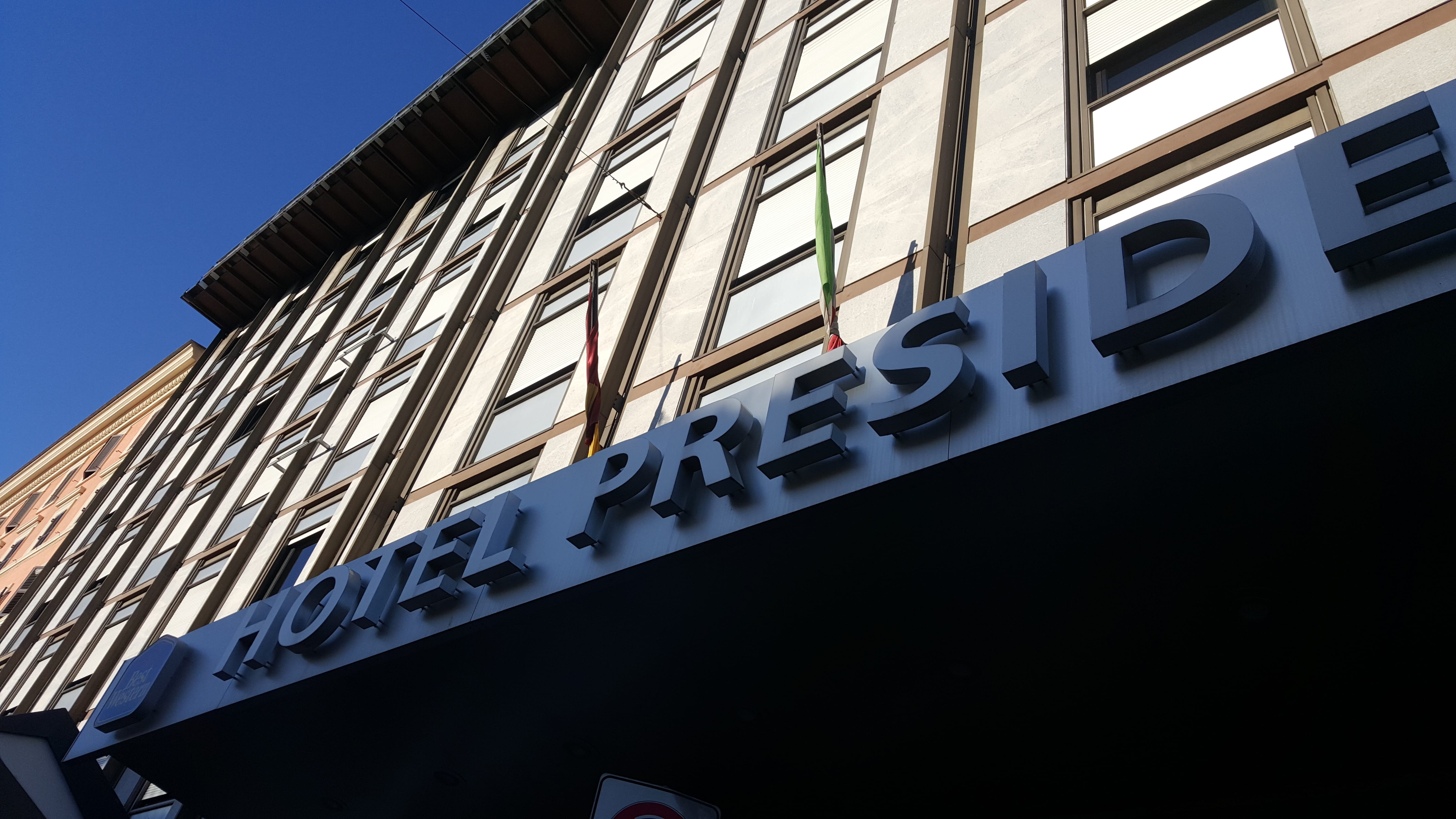
Hotel President
Our third-floor room at the Hotel President is stylishly modern, and reportedly more spacious than those of some others in the Gee Group. It is at the front of the building, so our large windows open onto the Via Emanuele Filiberto, a busy thoroughfare in the Esquilino district. Even though it’s Sunday, the noisy streetcar seems to be running as usual and people are hurrying in and out of the metro station across the street. Other guests staying at the hotel this weekend include a choir from some Chinese university and many other Asians, but there are also several English-speakers from the UK. We Americans wished each other a happy Mother’s Day as we filled our breakfast plates from a sumptuous buffet in the dining room. The Italian ham was particularly tasty; Michael supplemented his with a couple of boiled eggs and a croissant, of course–this one made with whole wheat. Nancy was disappointed to find the orange marmalade dispenser empty, but the apricot preserves were highly satisfactory. During breakfast, we learned that Cathy and Jeff J, unintentionally left at the hotel last night without knowing where the rest of us had gone, set off toward the Colosseum, found a good restaurant, and spent the evening listening to fascinating tales told by the woman from Moscow who shared their table. We wish we had gone with them!
The original itinerary for this “Travels of Paul” trip stated that we would attend an LDS sacrament meeting this morning and then, if possible, visit the site of the LDS Rome Temple. Yesterday Carol had informed us that our schedule would not, in fact, allow us to do both today, so she made the “executive decision” to forego sacrament meeting so we could visit the temple site. We didn’t know whether Roman Primary children would be honoring their mothers at church this morning, but Michael knew that none of the mothers in our group would be able to hear our own children or grandchildren sweetly sing in their respective sacrament meetings, so as soon as everyone was on the bus and ready to go, he usurped the microphone from the guide and warbled “Mother, I love you. Mother, I do. Father in Heaven has sent me to you….” All mothers present were duly moved.
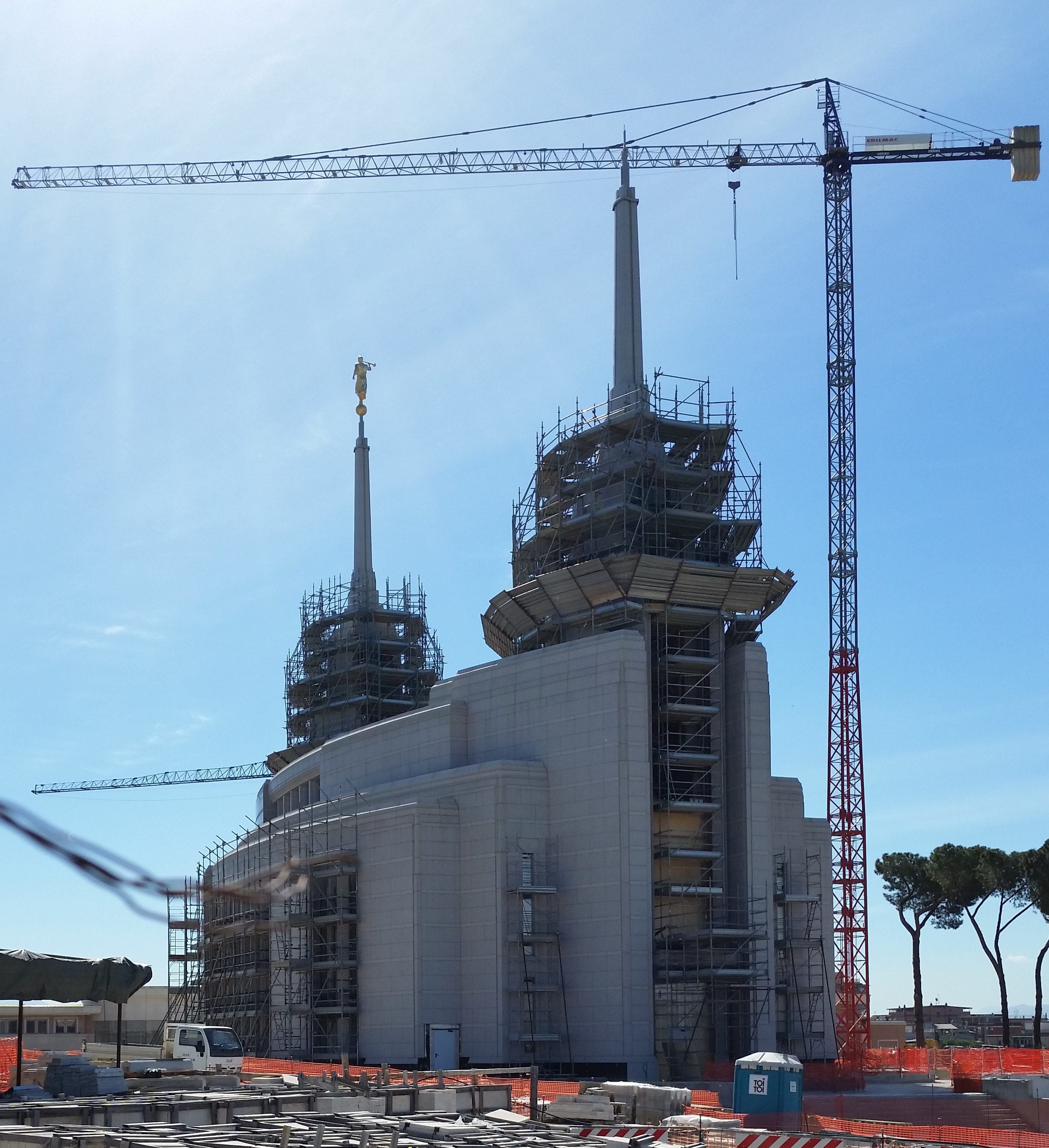
LDS Rome Temple under construction–still
During the 25-minute drive, Fabrizio drew our attention to a few of the many (many!) ruins and historic monuments we passed, but mostly he left us to our own thoughts or quiet conversations. The Rome Temple site is northeast of the city center, in a sector with more buildings erected since 1950 than in previous millennia. IKEA is within walking distance–which many Mormon temple-goers will probably consider a plus. After the Salt Lake Temple, which took forty years to construct, the Rome Temple may have the longest-running construction timeline of any other LDS temple. Begun in 2008, it still does not have an official opening date, and estimated completion is at least eighteen months away. Our understanding is that the problem is not one of budget deficits but of workmanship failing to meet the LDS Church’s high quality standards. Whole sections have had to be torn out and redone. Even though the construction site is surrounded by tall safety fencing, we could peek through the cracks and get a pretty good idea of how the building will look when completed. The sleek design will harmonize with the other modern structures in the vicinity rather than with the classical and baroque architecture found in other areas of Rome. (Think Brâncuşi rather than Bernini.)
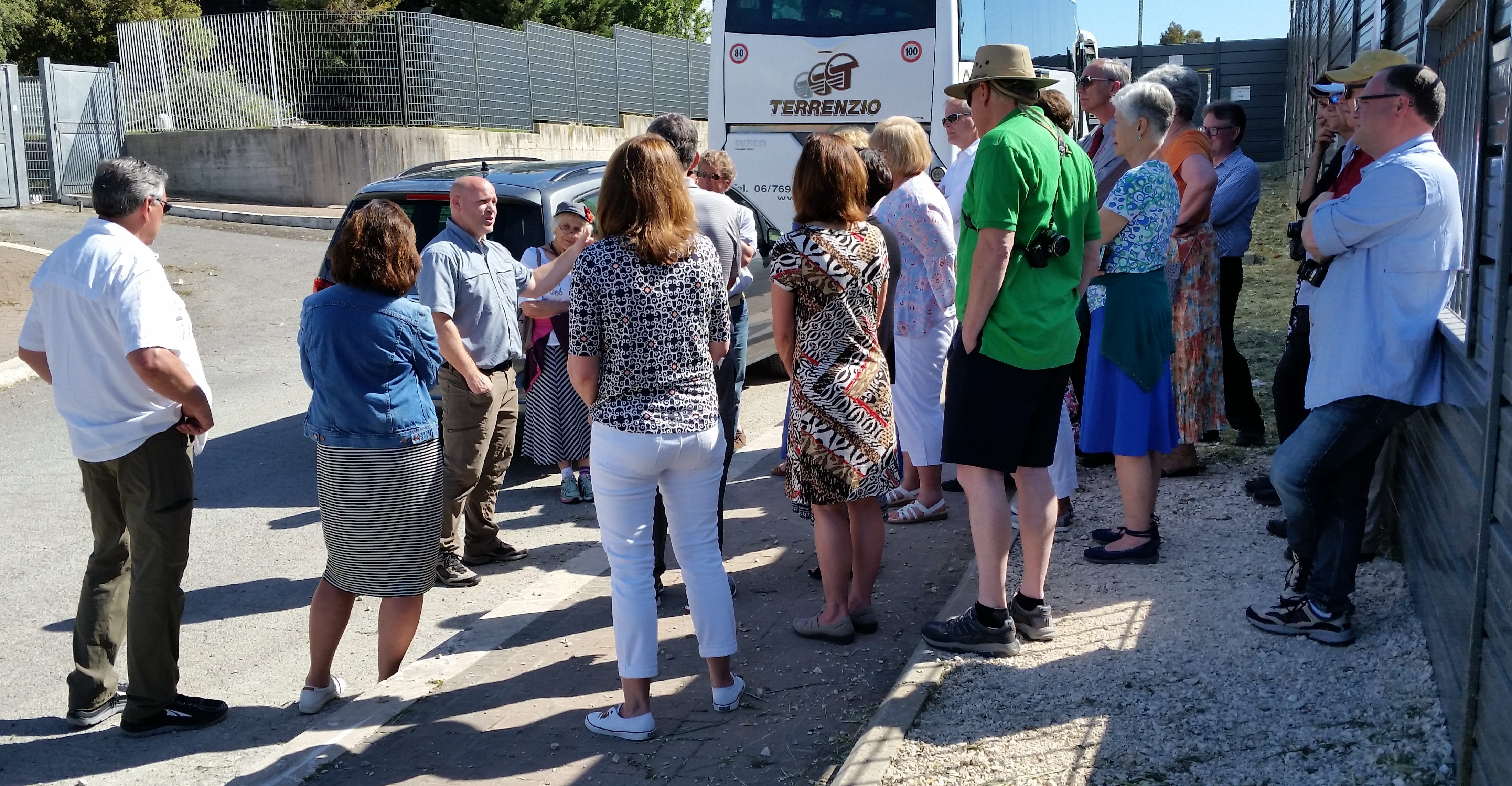
Listening to Joseph Brickey
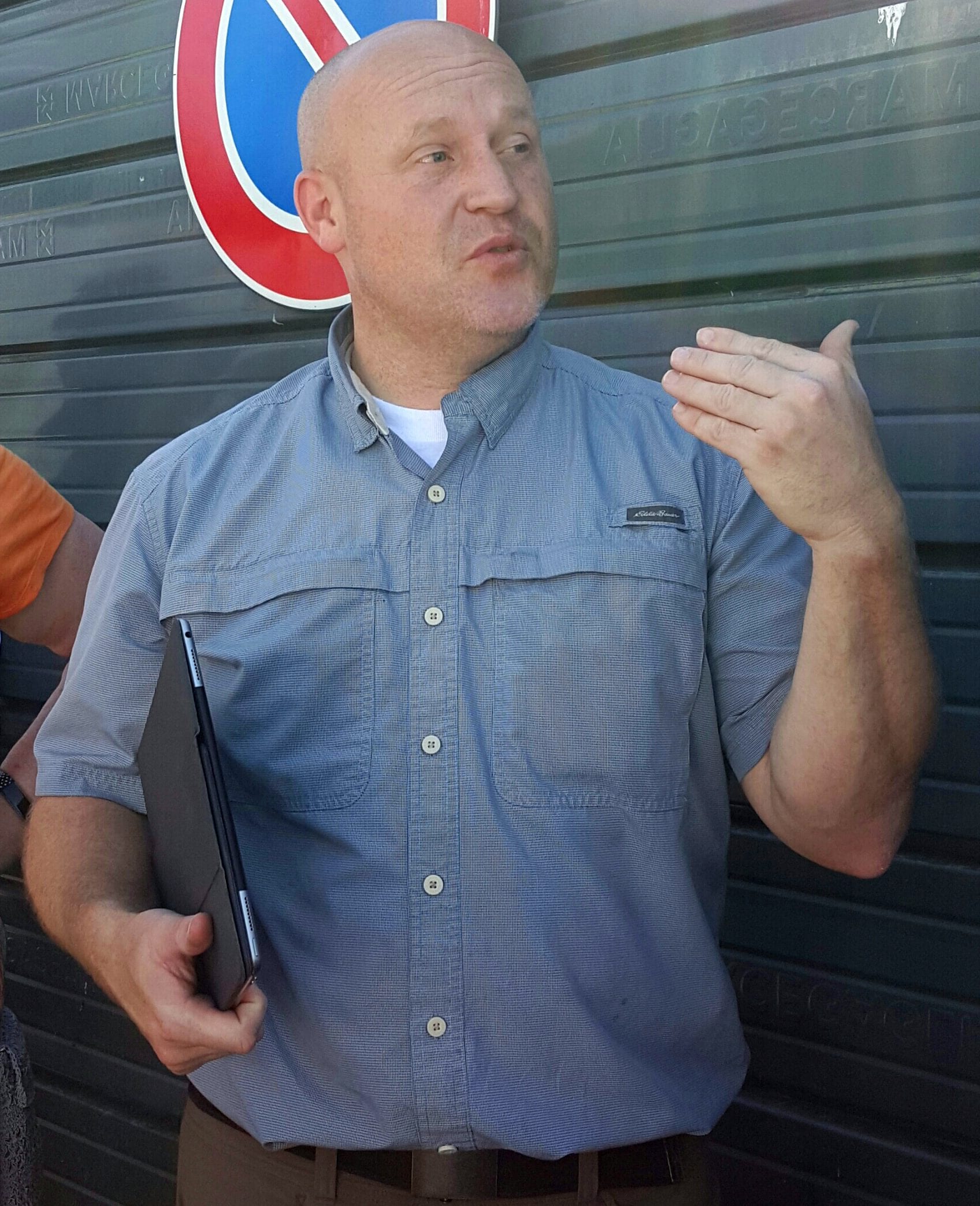
Joseph Brickey describing his work as a muralist
As some compensation for being locked on the wrong side of the fence, we did get to meet Joseph Brickey, the LDS artist who is painting murals for the visitor’s center also under construction on the temple grounds. (Joseph is a friend of Amanda’s son-in-law, who also happens to be in Rome right now on a work assignment.) He shared thoughts about his experience creating murals for the Copenhagen Temple several years ago, and how that has influenced his preparation for work on the Rome murals. He also described the complicated path he has had to navigate through many layers of Church hierarchy to win approval for his designs. Listening to Joseph’s explanation of his artistic thought process caused us to wonder how Michelangelo developed his designs for the Sistine Chapel and other religious works, and how difficult it might have been for him to have them approved by church officials.
On the bus ride back toward central Rome along Via Catania, several of us had a chance to admire the work of another artist–or at least photos of her creations. We persuaded Eva, a professional seamstress and pattern designer, to pass her phone around so we could see examples of the beautiful smocked clothing she has made for her grandchildren. (Check her blog, Sew Much Good, to see some of her work.) Eva has a medical condition that limits her peripheral vision, but her central focus must be incredibly sharp to do such intricate handiwork.
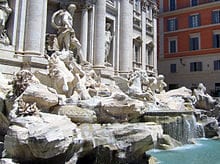
The crowd made getting close to the water in the Trevi Fountain difficult, but we were glad to see that the heavy grime that used to blacken its marble statuary has been scrubbed off since 1978
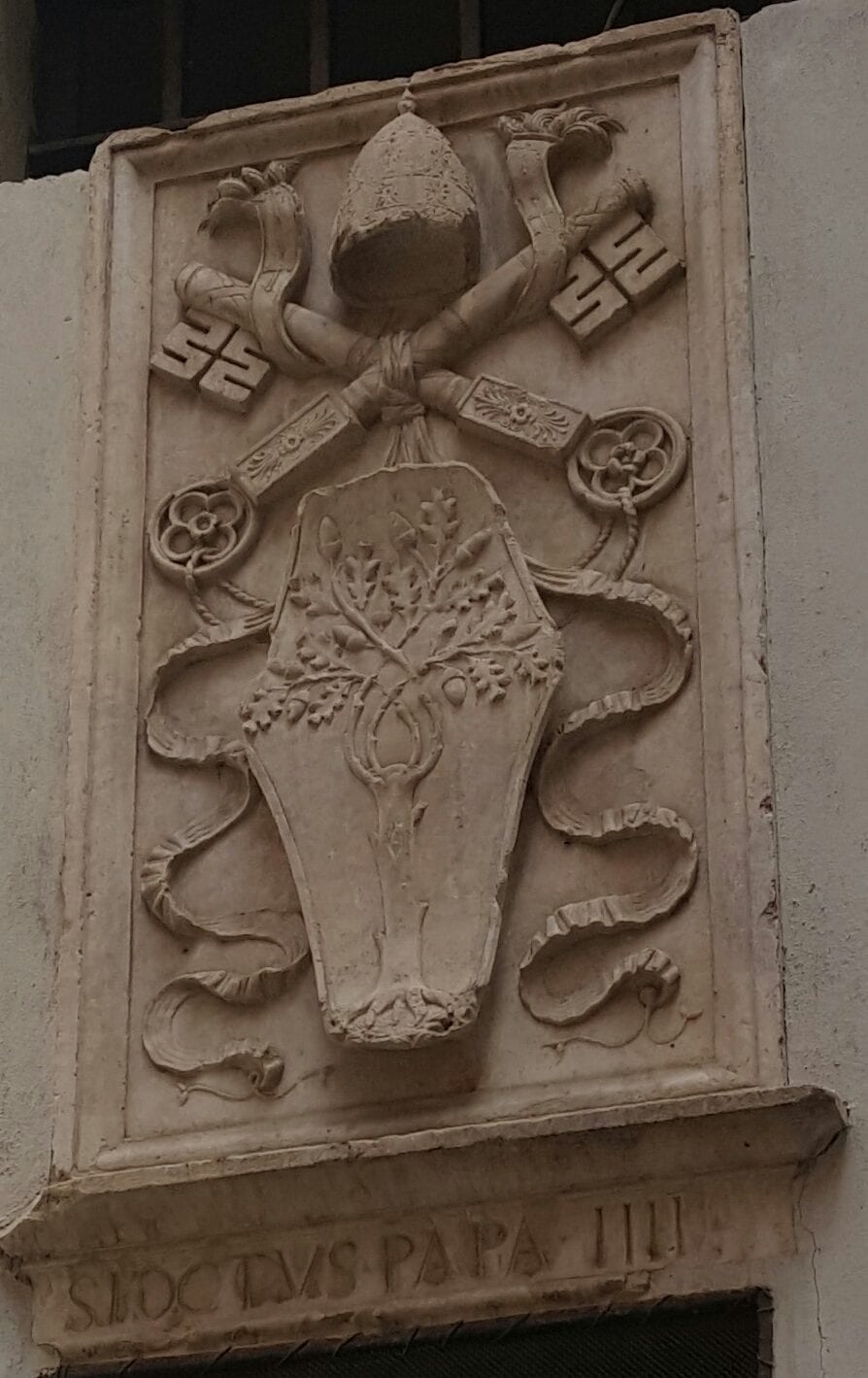
The coat of arms of Pope Sixtus V, whose ambitious public works projects were critical to the 16th-century revitalization of Rome
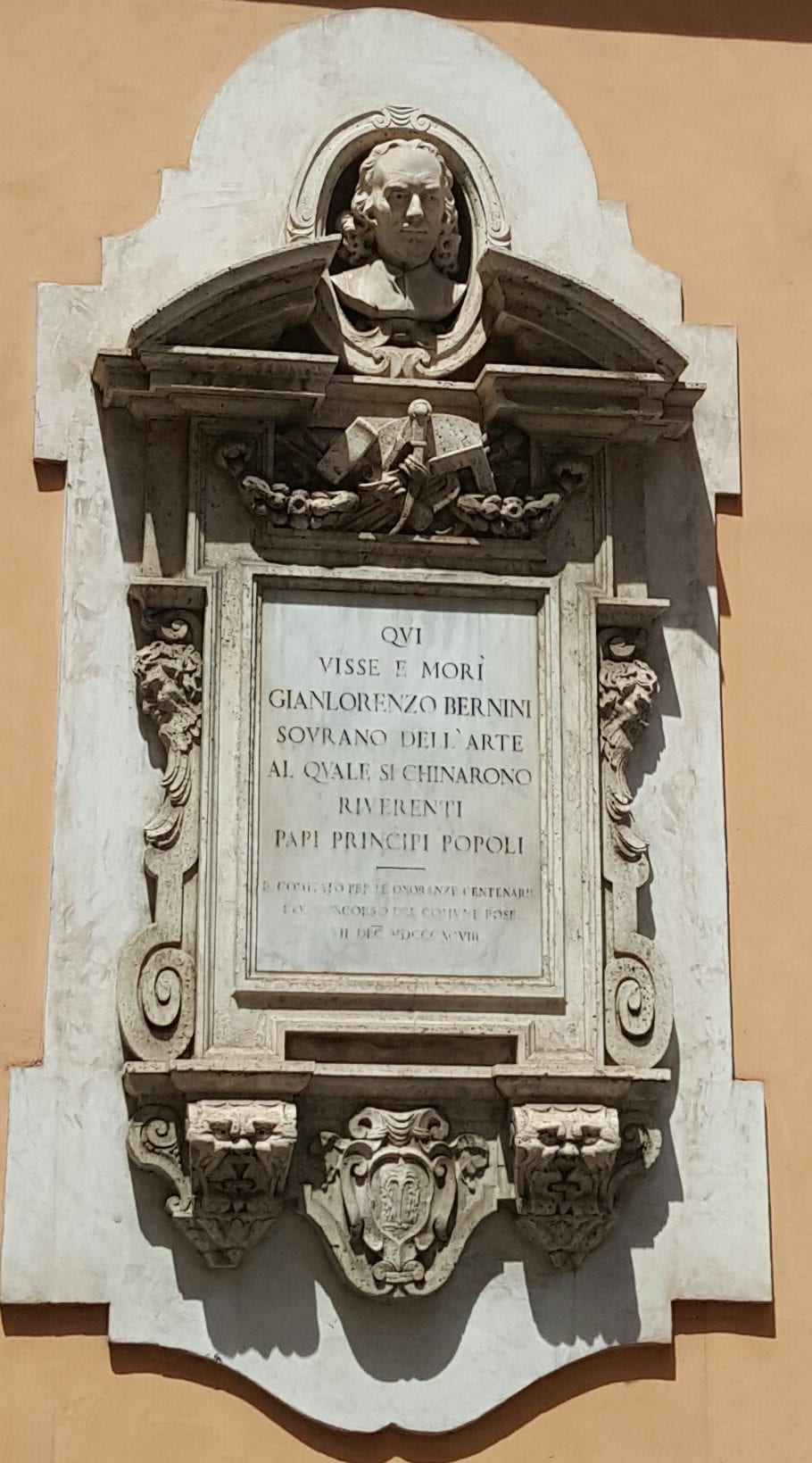
A plaque on the home of Gianlorenzo Bernini, the 16th-century sculptor and architect who designed the Piazza di San Pietro, as well as the Baldacchino and the elaborate Chair of St. Peter inside St. Peter’s Basilica
The bus let us off as close as we could reasonably get to the Trevi Fountain, and we spent most of the rest of the day following Fabrizio on foot. Although he knows our group is focusing on Christian historical sites, he doesn’t want us to neglect other “must-sees” in between, so a stop at the famous fountain was obligatory. As we made our way there through crowded, narrow streets, Fabrizio pointed out sections of the Acqua Felice, the aqueduct built in the sixteenth century under the direction of Pope Sixtus V (whose birth name was Felice). Sixtus V was determined to raise fallen Rome above even the glorious heights it had reached under the Caesars, and reconstructing its once-famed water system was an essential first step. Sixtus V’s vision for rebuilding Rome included a network of broad, straight avenues connecting the city’s major basilicas, a uniform architectural style, and repurposing ancient monuments. (The Colosseum, for example, was to become both a silk-spinning factory and a home for its workers.) Not all of his expansive–and expensive–plans came to fruition, and some resulted in the desecration of irreplaceable antiquities that the Pope deemed unworthy of conserving. He also was known to exploit the poor and execute errant nuns; nevertheless, Rome must thank Sixtus V for much of the baroque grandeur that has attracted countless visitors for five centuries.
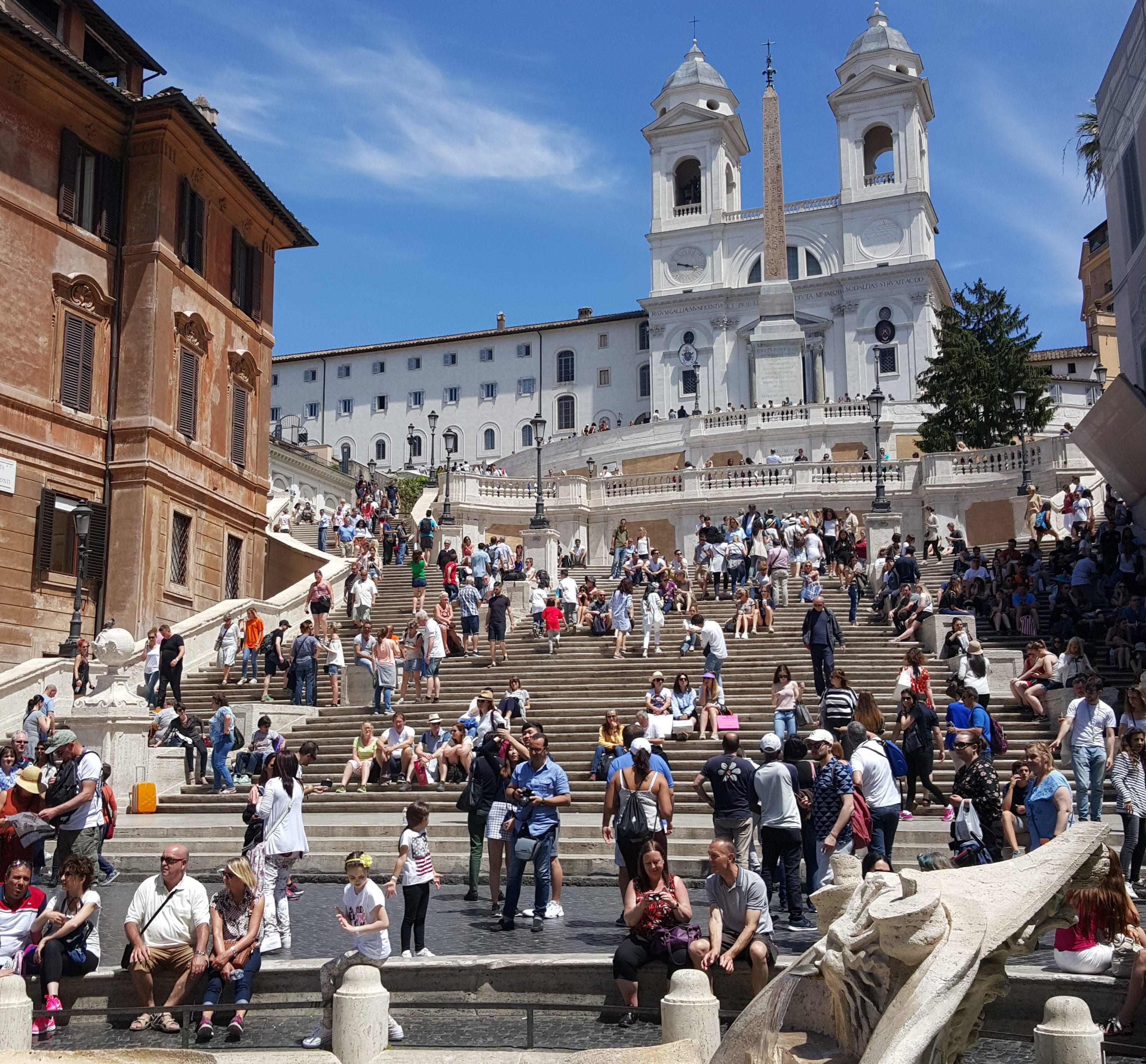
Fabrizio suggested that the Spanish Steps probably should be called the French Steps because although they ascend from the Piazza di Spagna, the French government maintains the Church of Sanctissima Trinità dei Monti at the top
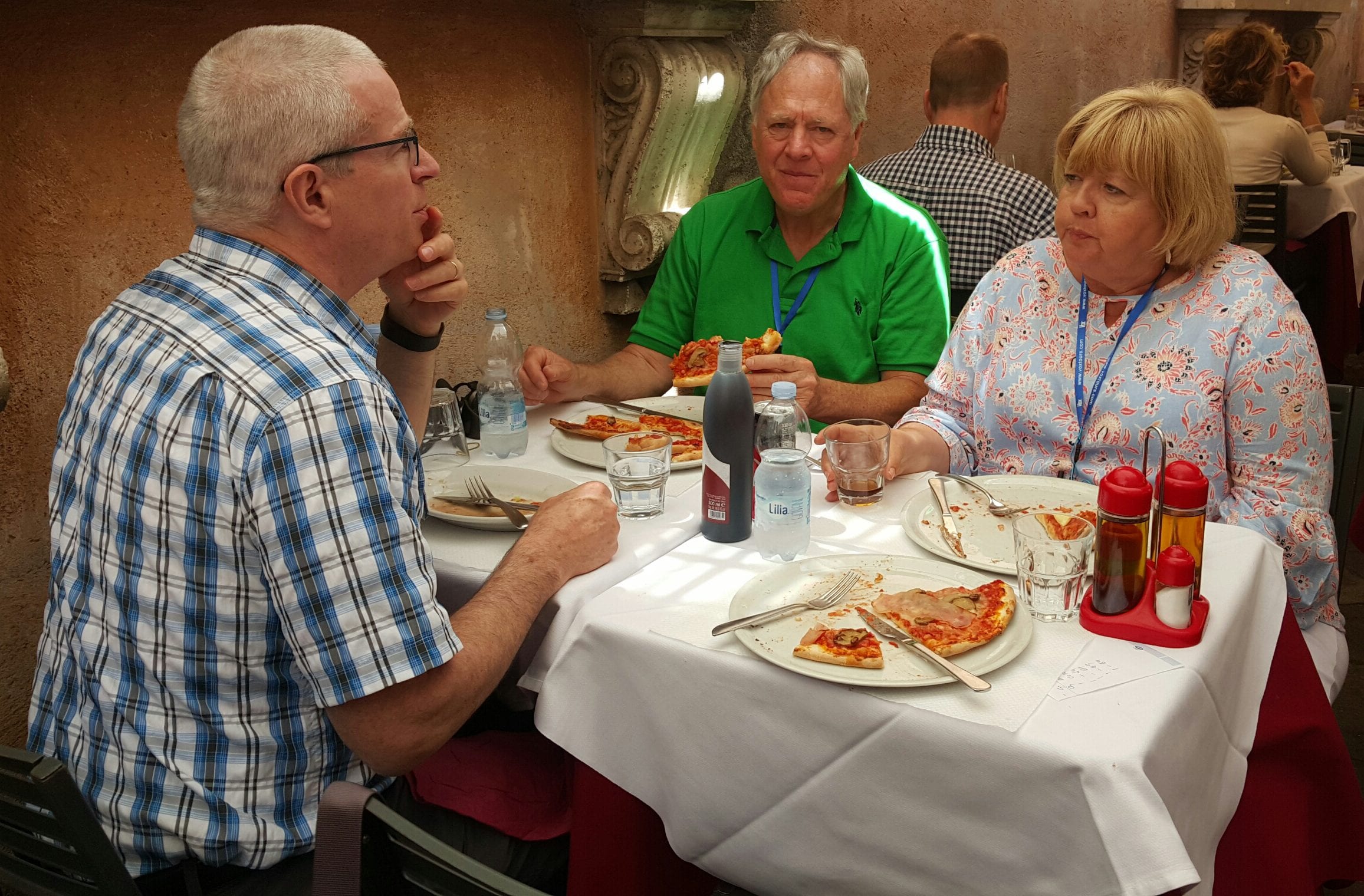
Lunch with Jeff and Cathy
At the Piazza di Spagna, Fabrizio told us that Romans had regarded the 1986 opening of Italy’s first McDonald’s there as an assault on their cultural heritage. Despite their protests and attempts to have it removed, the American icon remains–but when lunchtime came and Fabrizio allowed us to scatter to find something to eat, everyone eschewed the purveyor of Big Macs. We headed down a less crowded side street with Cathy and Jeff and, deciding that the tables outside the Tavola Calda Bar looked inviting, sat down and ordered a nice caprese salad and a mushroom pizza. Each of us had to wait quite a while for a turn in the bar’s single W.C. The sink was located at the bottom of a dank stairway next to the kitchen, but to reach the toilet, one had to ascend another half-flight of stairs–a “throne” in position, though hardly in opulence.
Reassembling after our lunch break, we got back on the bus to ride a couple of miles to the Colosseum. Fabrizio gave us a chance to photograph the exterior from a good vantage point, but because our entrance appointment wasn’t until later in the afternoon, we walked past the arena and visited some other famous ruins first. As we did so, Fabrizio reminded us that “architecture reflects politics”; we certainly can see that concept at work here in Rome.
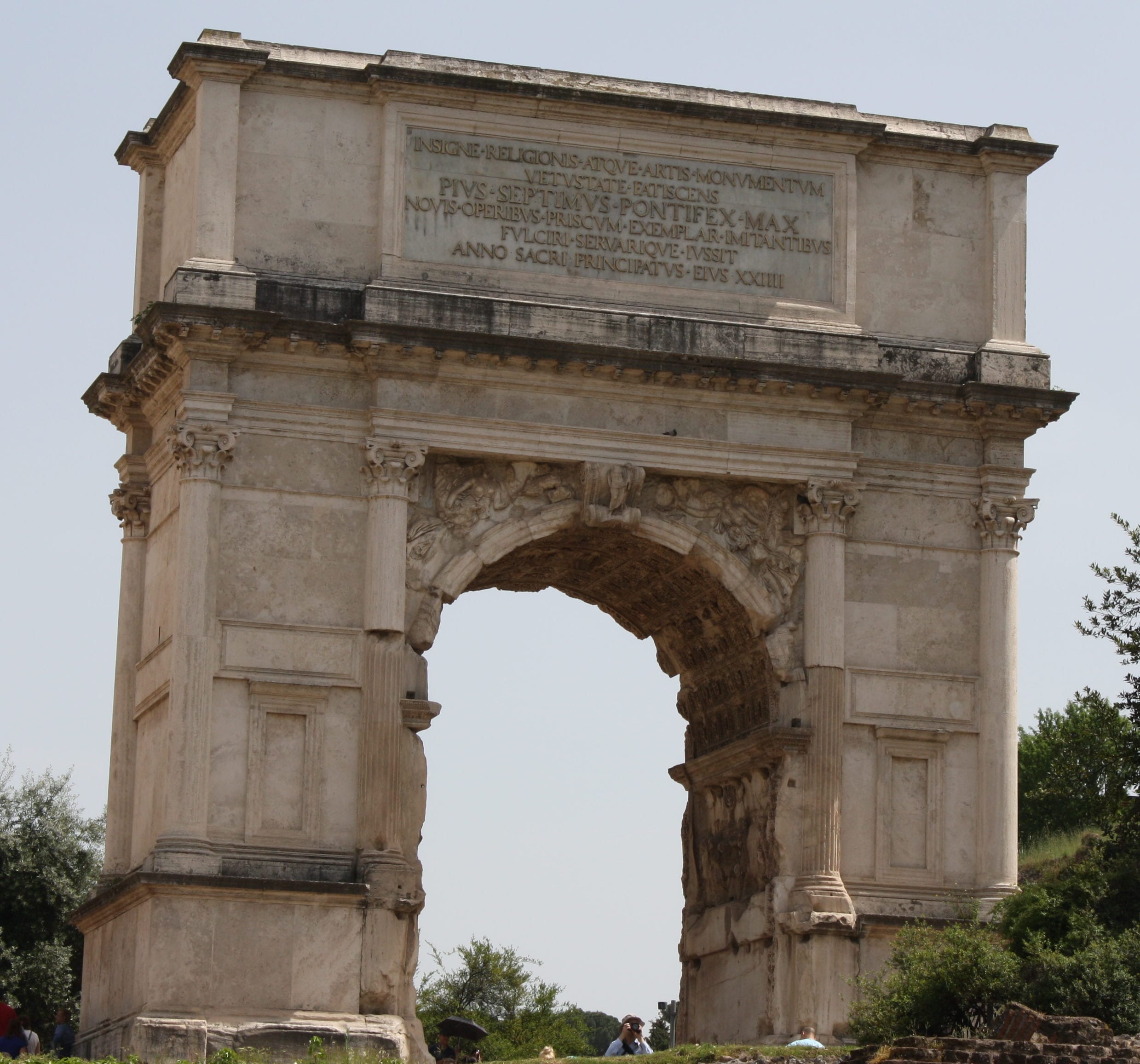
Arch of Titus
The Arch of Titus, erected by Domitian in 82 AD to commemorate the victories of his late brother, started a trend in monumental architecture that would endure for hundreds of years. A frieze on the inside depicts the army of the Roman general absconding with sacred objects from the Temple in Jerusalem following the defeat of the Jewish rebels.
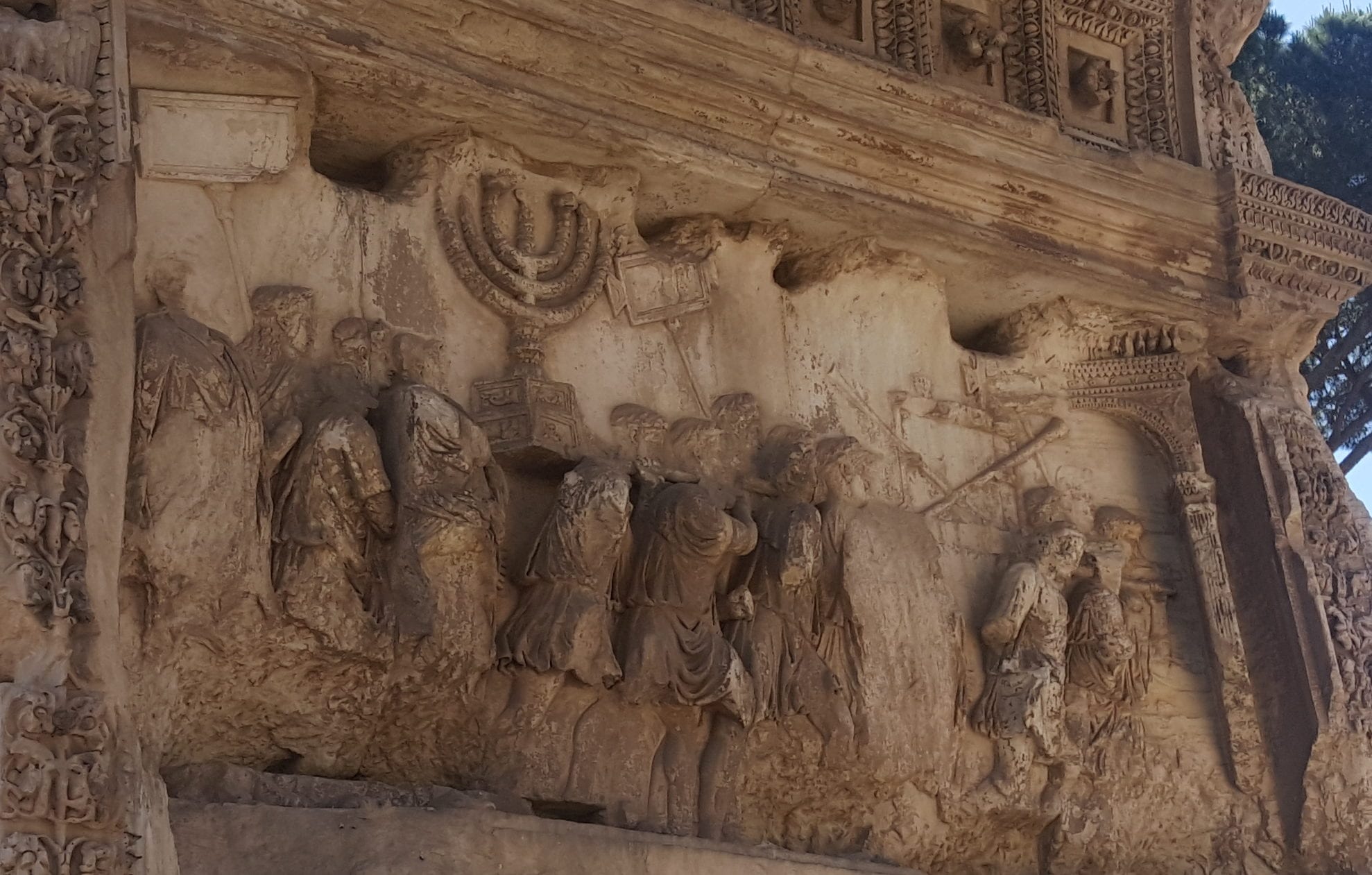
Looting relics from the temple in Jerusalem
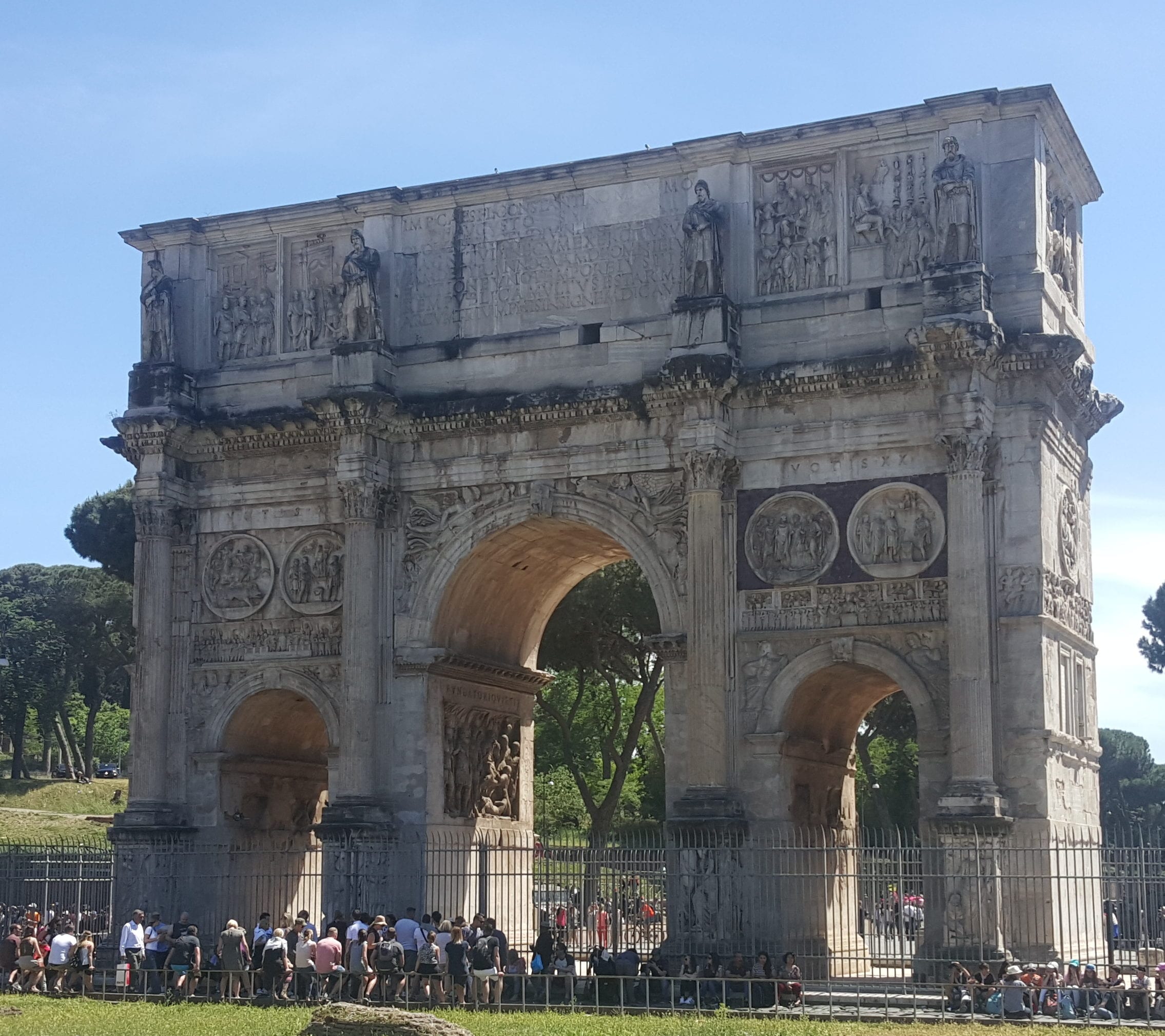
Arch of Constantine
The Arch of Constantine, constructed in 315 AD, is the largest and youngest of Rome’s extant triumphal arches. It cannibalized elements of monuments to earlier heroes of the Empire and thus is something of a sculptural collage.
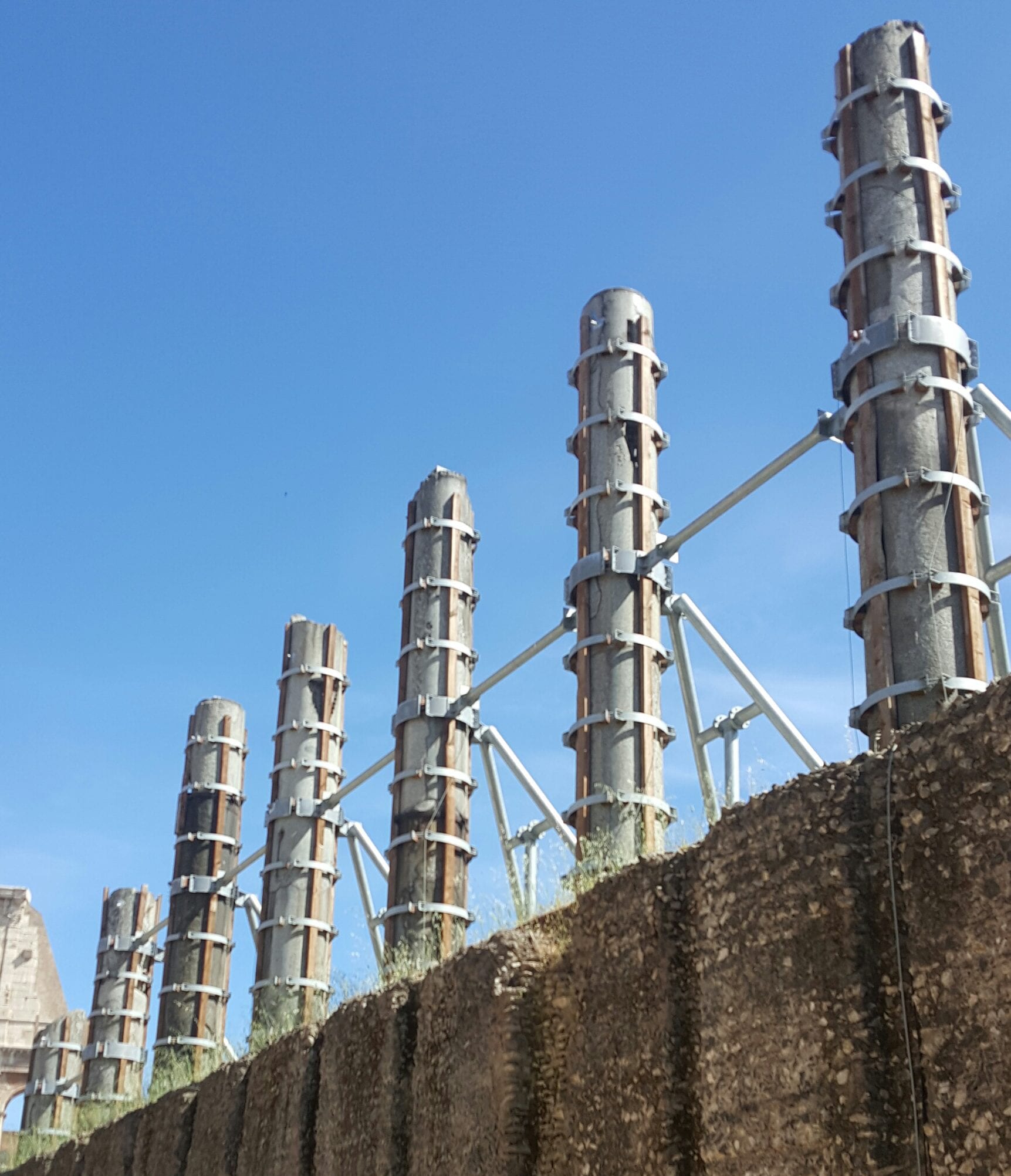
A rebar framework shores up the ruins of the Temple of Venus and Rome at the east end of the Forum while a new subway line is constructed nearby
The Forum, the Roman version of a Greek agora, functioned as the city’s civic center from the eighth century BC through the sixth century AD–fourteen hundred years of continuous activity. During the next several centuries, the area, which encompasses over a hundred acres, was left to nature, and its overgrown ruins served only as a source of romantic inspiration for artists and poets. Archaeological excavation did not begin in earnest until the late nineteenth century and continues today. The mixed-up architectural styles of the ruins indicate how fragments of ancient monuments have been recycled or old structures remodeled to accommodate different needs across the centuries. We were overwhelmed by the amount of history the Forum has seen–and the number of structures whose names and dates we are trying to keep straight.
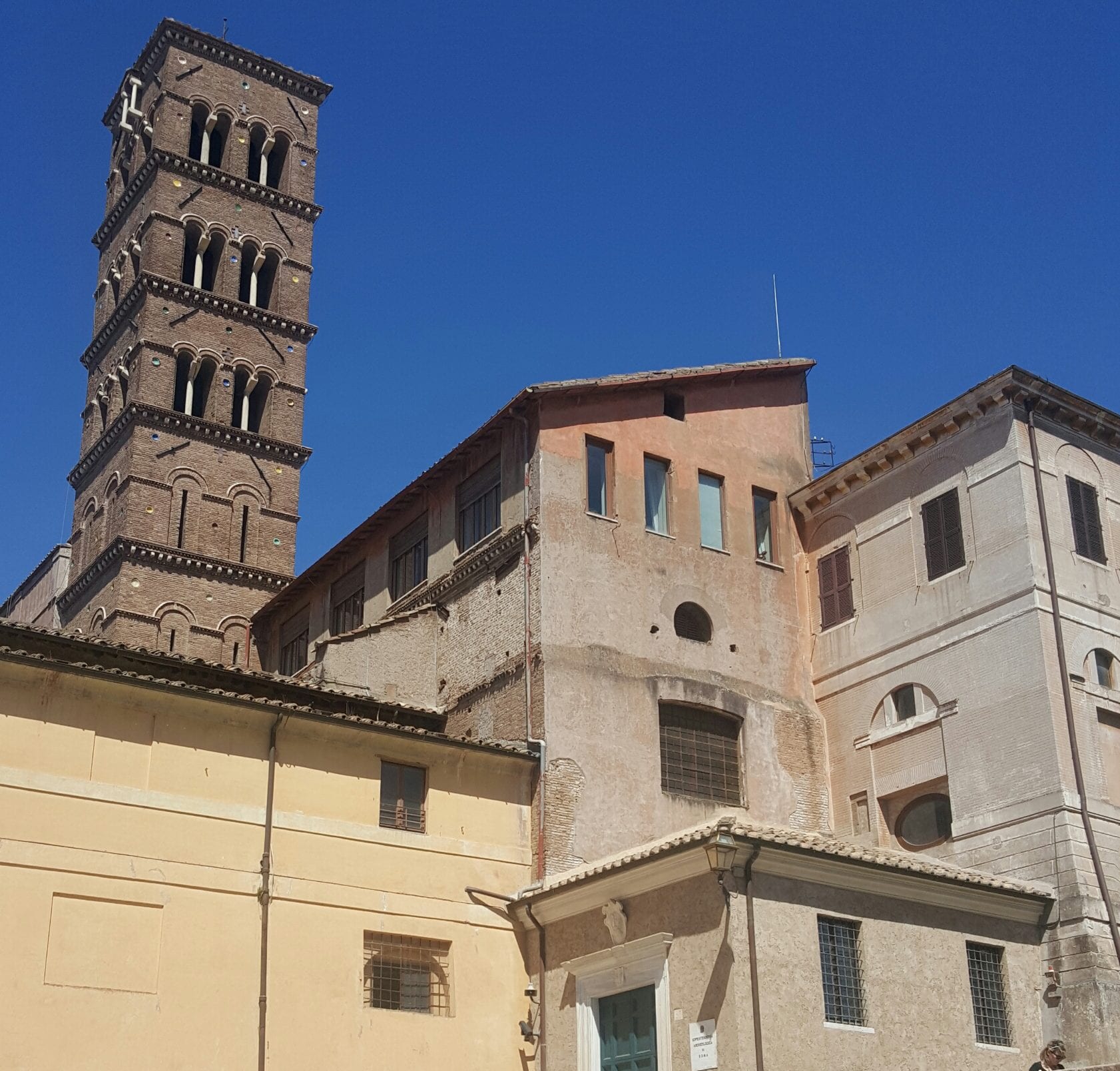
The Basilica of Santa Francesca was established in the tenth century, but has had many later additions. It stands at the east entrance to the Forum
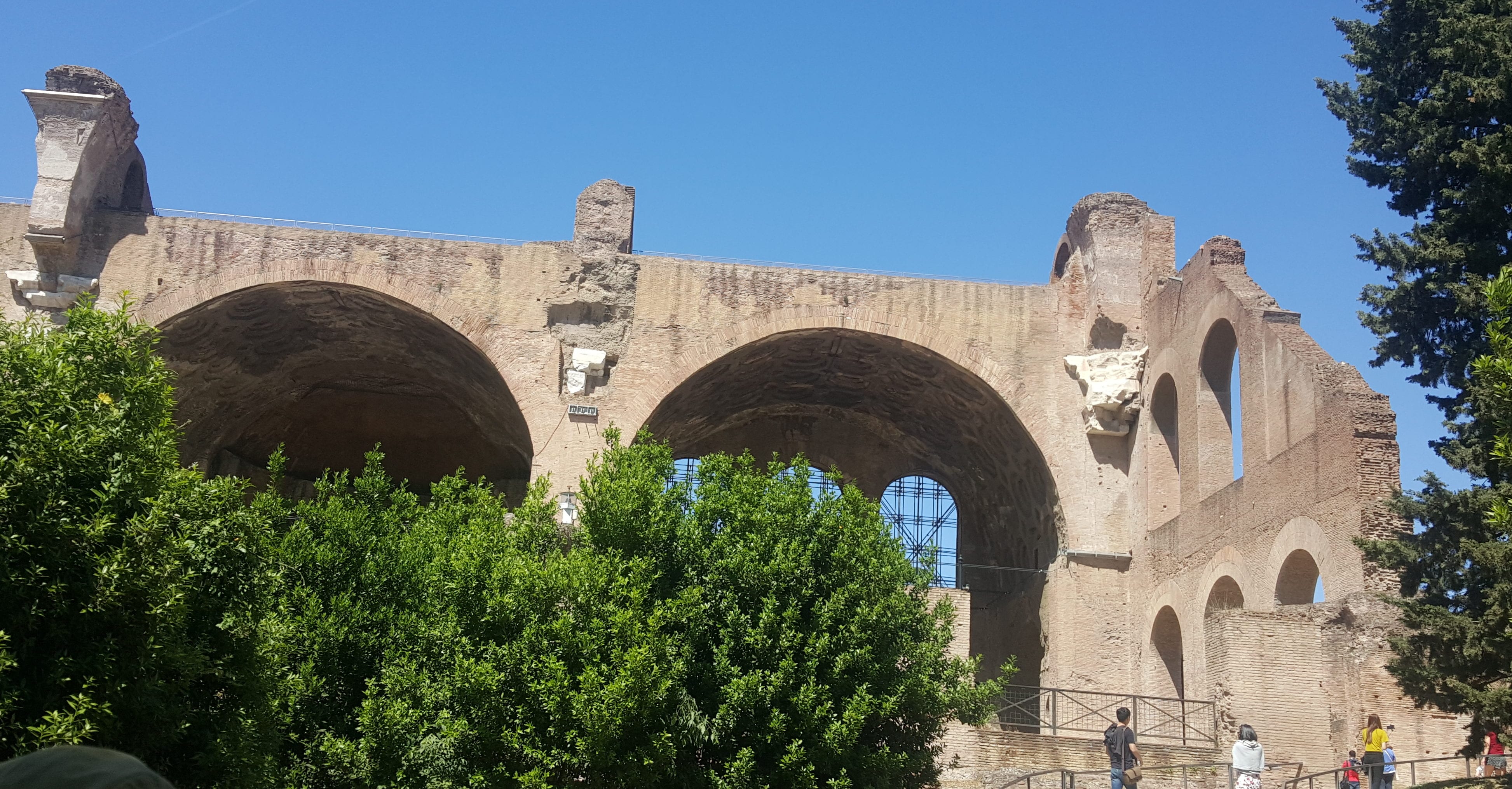
The remaining vaults of the Basilica of Maxentius
One of the most impressive ruins we encountered was the Basilica of Maxentius. Completed in 312 AD, it was the largest building ever constructed in the Forum, and was used originally for council meetings, court hearings, and public assemblies. The vaulted basilica format, with its wide-open interior space, was adopted as standard for Christian churches both because it can accommodate a large congregation and because it was not as closely associated with pagan worship as the post-and-lintel format of most Greco-Roman temples. Only a side aisle of the Basilica of Maxentius is still standing, but the huge barrel vaults make it easy to imagine how enormous a place it must have been.
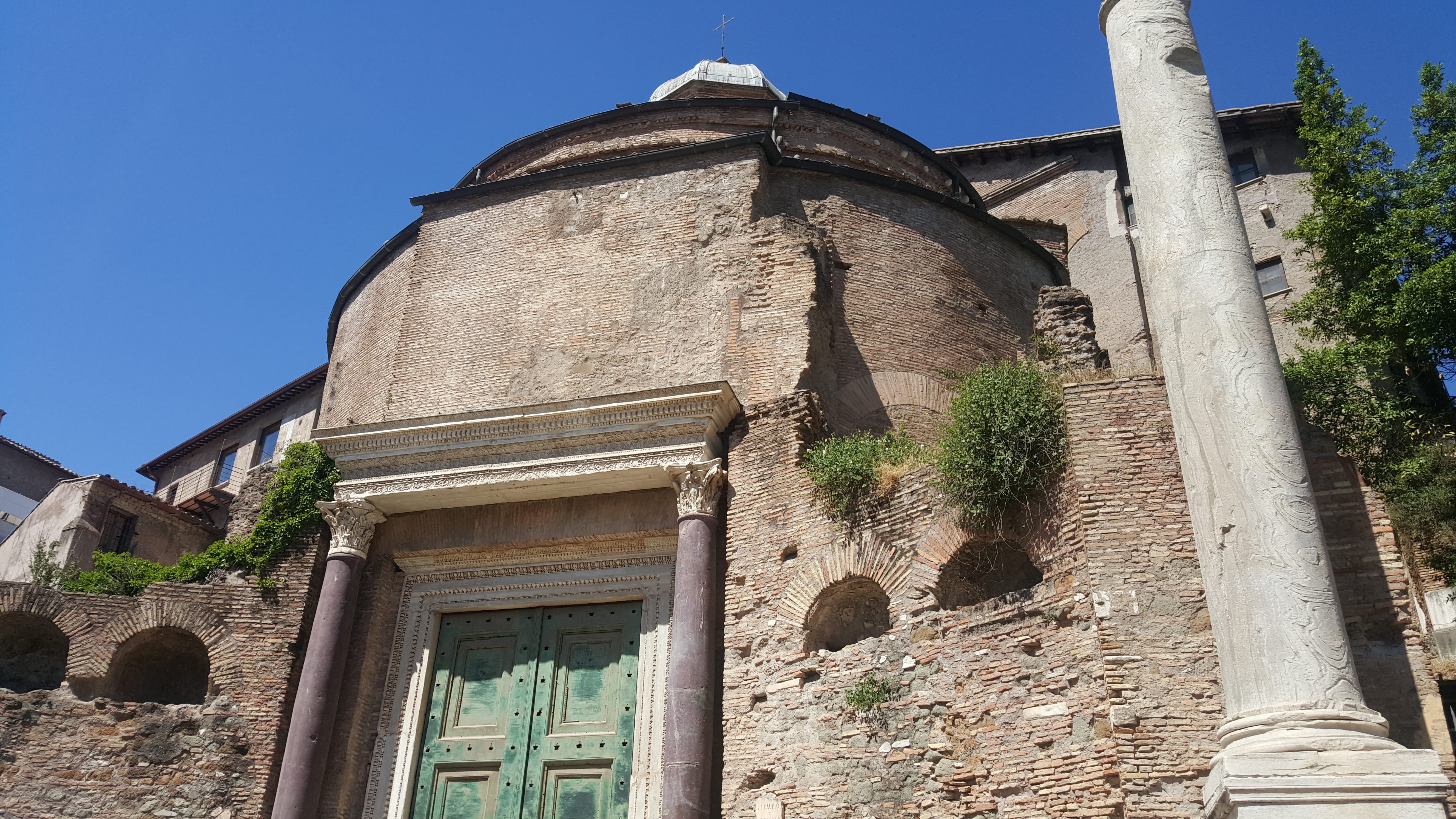
Temple of Romulus
The Temple of Romulus was built a few years before the Basilica of Maxentius to honor Maxentius’s son, who died young. It later became the Christian Basilica of Santi Cosma e Damiano, dedicated to two martyred brothers who had been doctors.
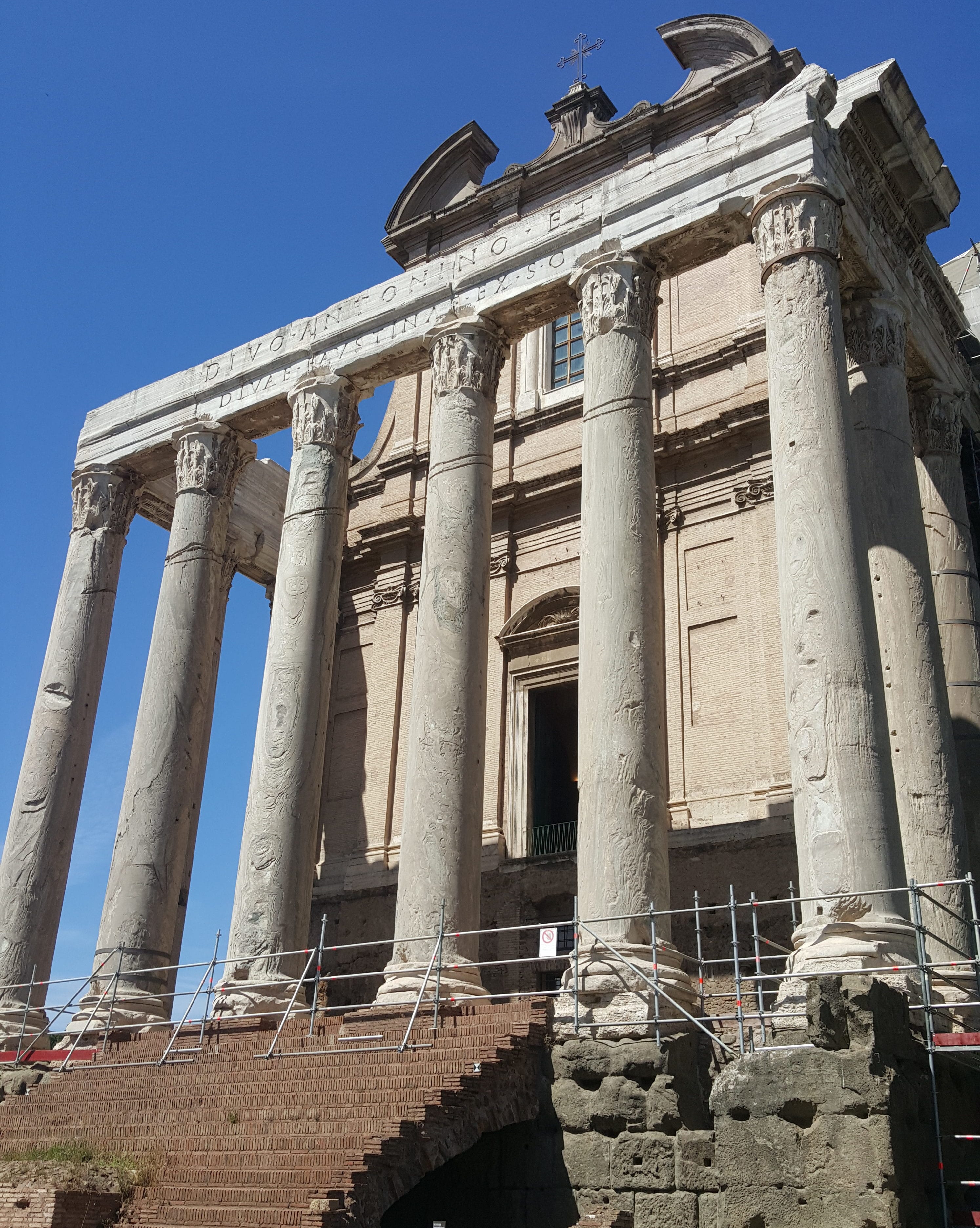
Temple of Antoninus and Faustina
The 2nd-century Temple of Antoninus and Faustina was converted to the Church of San Lorenzo in Miranda. (Saint Lawrence may or may not have been martyred on the site.) Since the Renaissance, it also has been the home of a medical college.
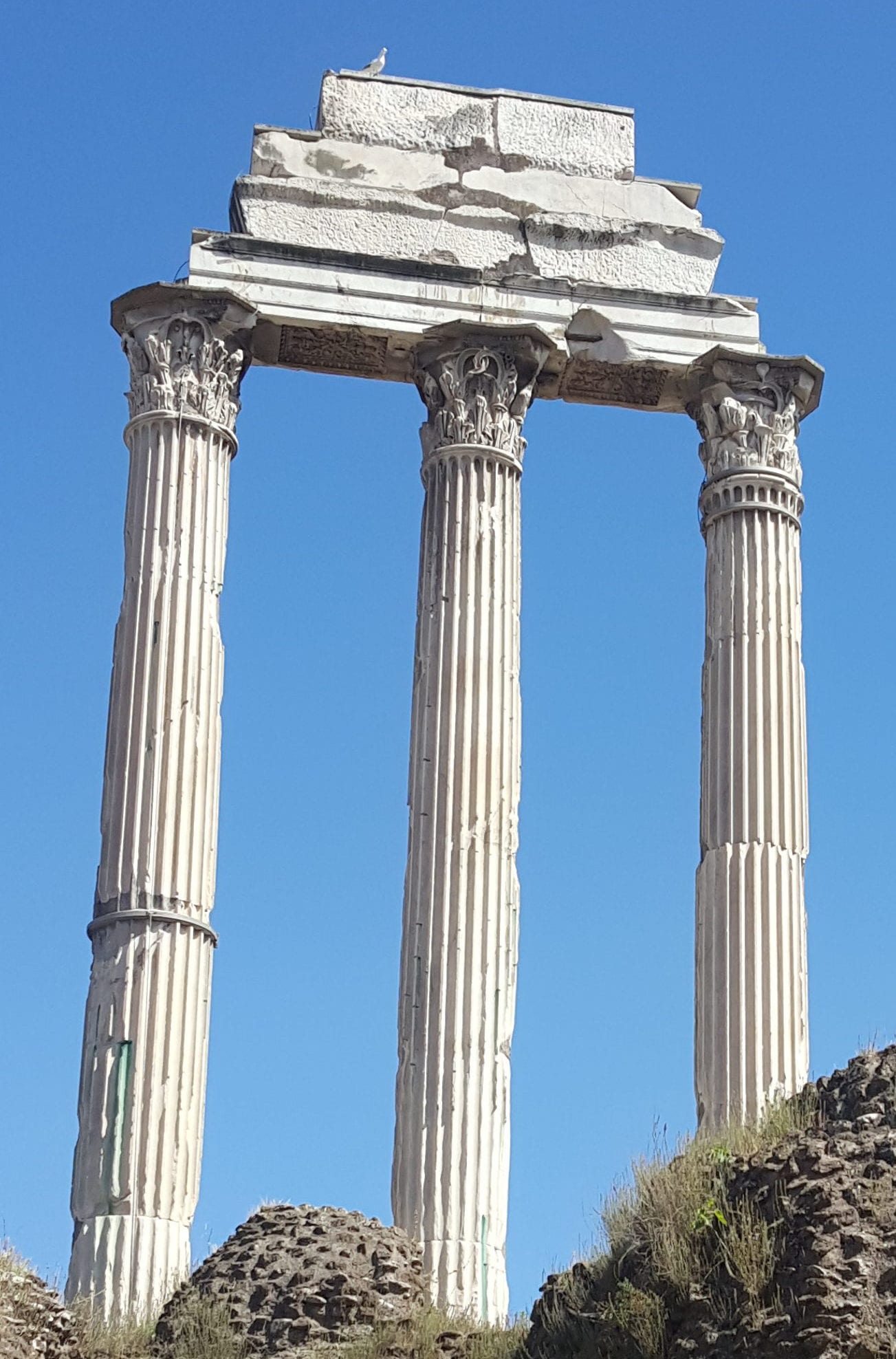
Temple of Castor and Pollux
Three columns are all that remains of the Temple of Castor and Pollux, and constitute one of the oldest ruins in the Forum. The temple was built in the 5th century BC, and was sometimes used as a secret meeting place for Roman senators.
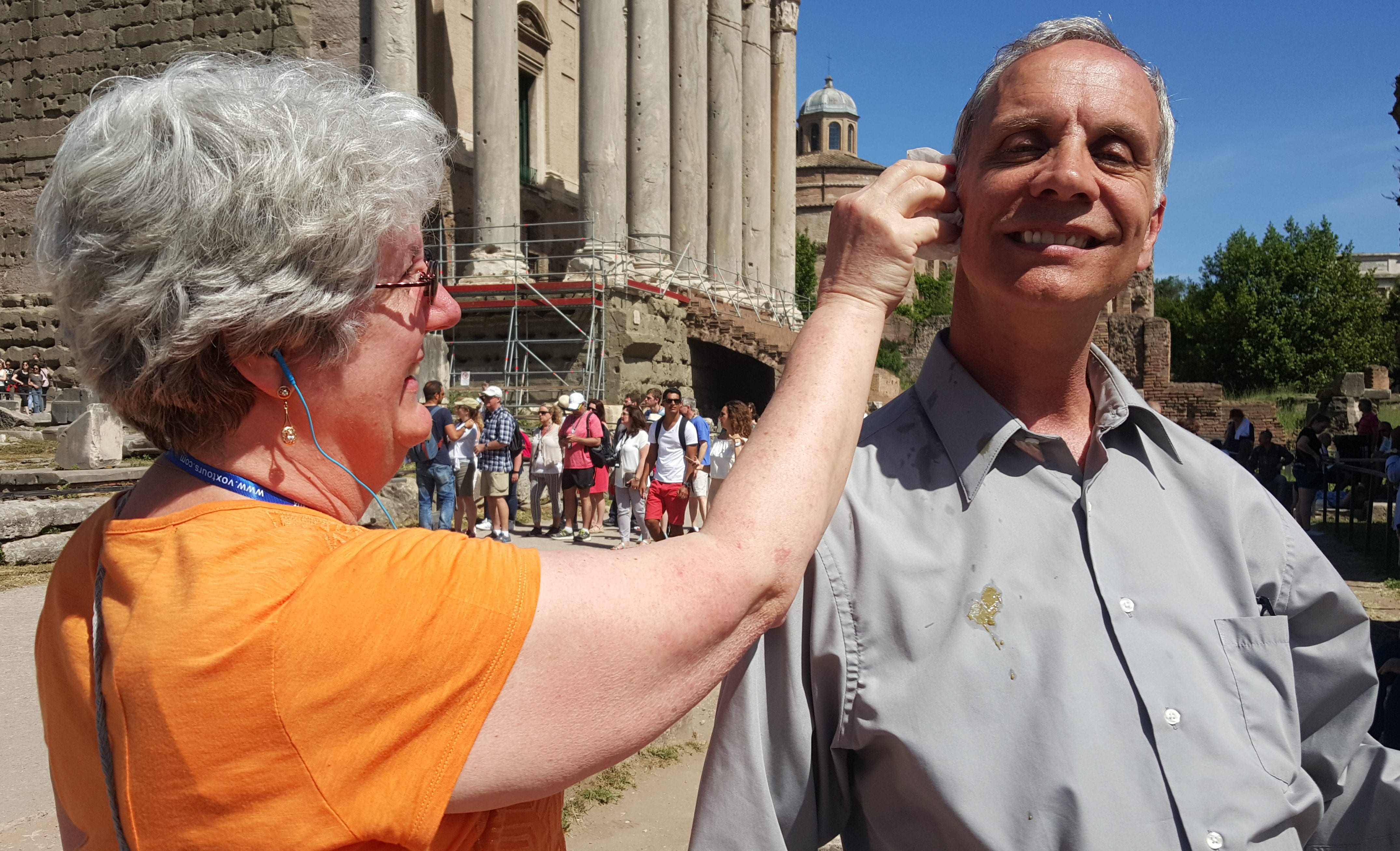
Lynn and Mark will remember the Forum as the site of a bird-bombing during our visit
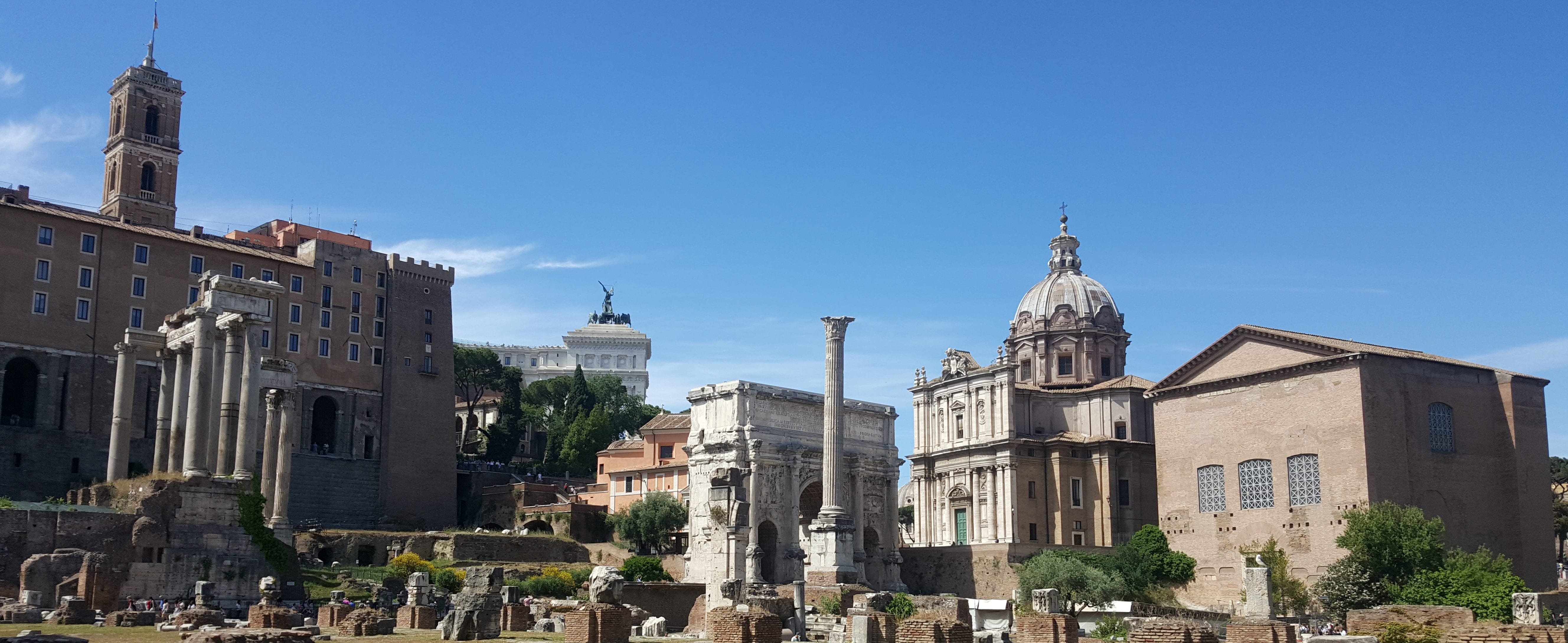
The west end of the Forum
The west end of the Forum includes the Tabularium (the ancient records office, left background), the Temples of Saturn and of Titus and Vespatian (overlapping in the left middle-ground), the Septimus Severus Arch (center), the Church of Santi Luca e Martina (with the dome), and the Curia Julia (far right). The Curia Julia was the primary home of the Senate during the reign of Julius Caesar, but this is not where he was assassinated; in 44 BC, the Senate was temporarily meeting at the Theatre of Pompey while the Curia was being remodeled.

The Colosseum
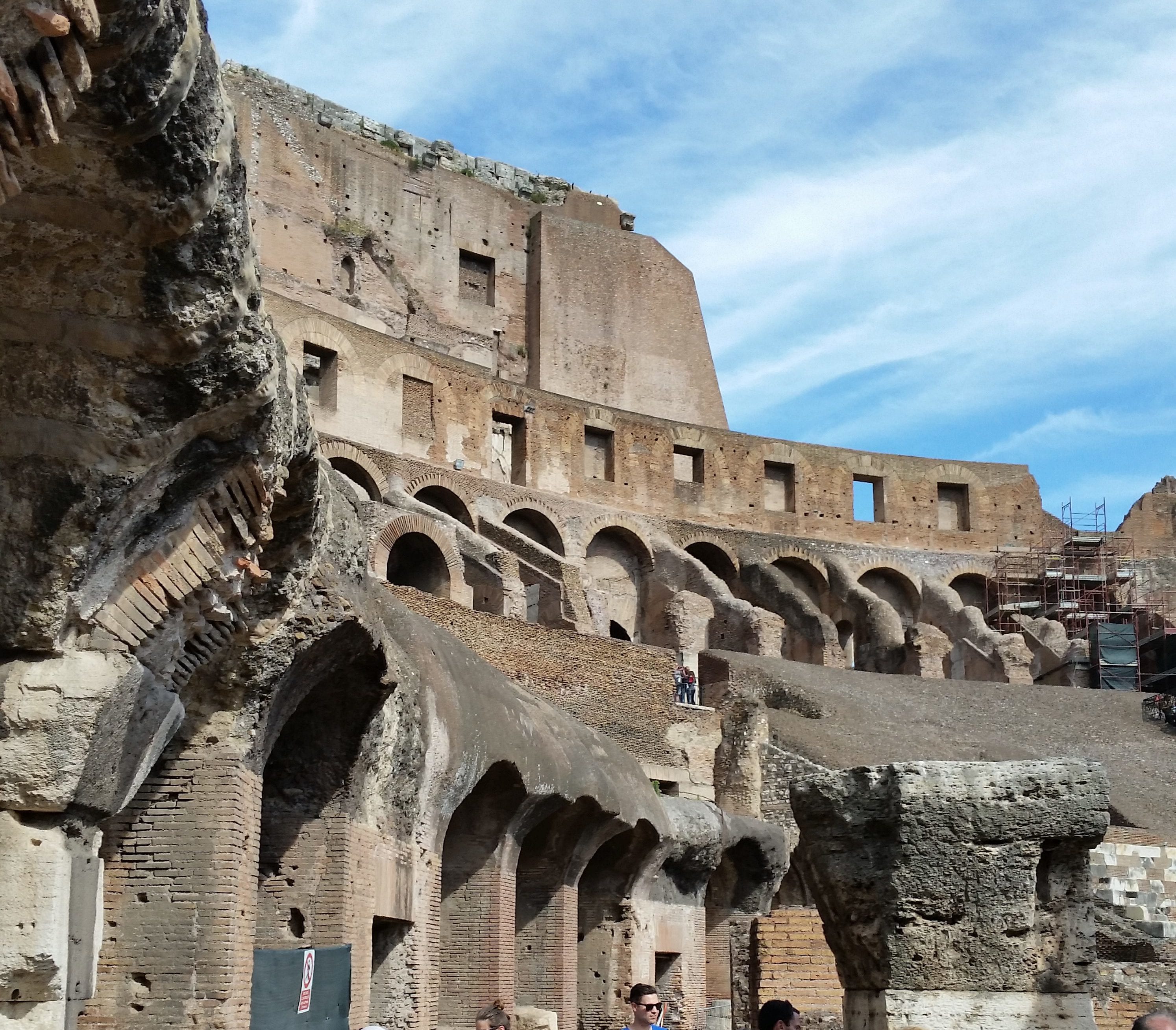
Various levels for spectators
After completing a full circuit of the Forum, we lined up with hundreds of other mid-afternoon visitors for our turn inside the Colosseum. (Average daily attendance: 11,000.) For six centuries, the grand arena was the scene of near-continuous entertainment, fifteen to eighteen hours a day. (Imagine trying to be the impresario!) Events were open to the entire populace of the res publica, so a capacity crowd of 60,000 represented all strata of Roman society. As in similar venues today, rulers and wealthy citizens lounged in luxury boxes near the field; plebes had to crowd into the nosebleed sections.
Fabrizio helped us understand that contrary to the impression set by Hollywood, not every spectacle presented in the Colosseum involved gruesome contests in which Christians were thrown to ferocious lions or gladiators hacked each other to death. Most events were more like circus shows, featuring jugglers, clowns, magicians, and performing animals. Even most of the celebrated gladiator contests were more like World Wide Wrestling matches, with teams of celebrity fighters engaging in theatrical stunts that allowed them to live and fight again. Fabrizio said that on the occasions when there was a fight to the death, and the fate of the contestants was in the hands—literally—of the presiding official, he did not use his thumb to signal his decision; rather, he used a closed fist to grant life, and an open hand to condemn the loser to death. (Sorry, Joaquin. Ridley Scott directed you to do the wrong thing.)
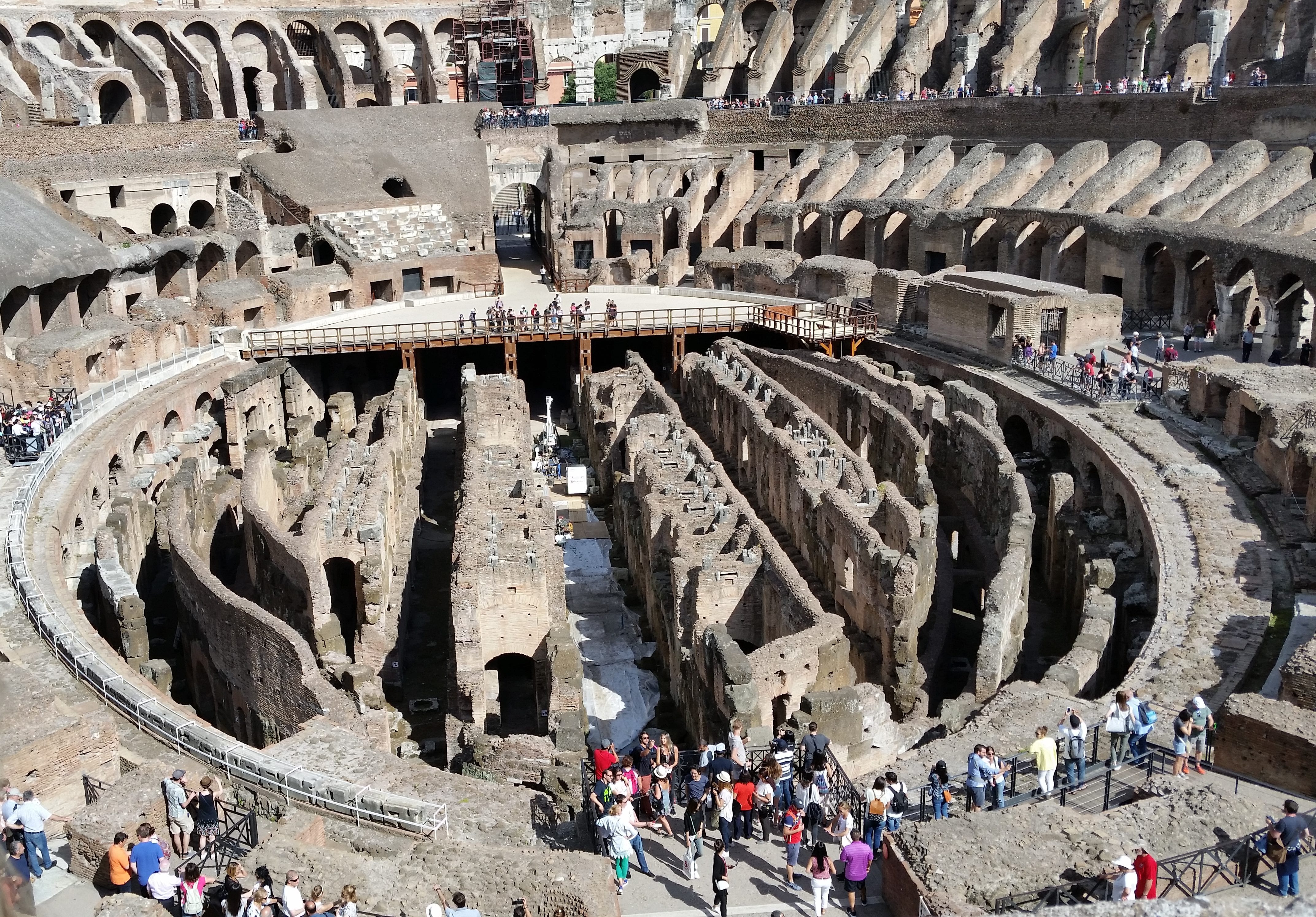
Remains of the once-subterranean stalls where animals, gladiators, and other performers waited for their turn on the field
Our guide also described scenes that looked much like what we’ve seen at twenty-first-century pro sports events and rock concerts: as much action in the parking lot and in the arcades behind the stands as on the field. Fans outside the arena engaged in the ancient equivalent of tailgate parties; vendors inside hawked snacks and souvenirs. And not all attendees were interested in the program. Fabrizio aptly summarized what went on in the Colosseum as “eating, drinking, and sex under the arches.”
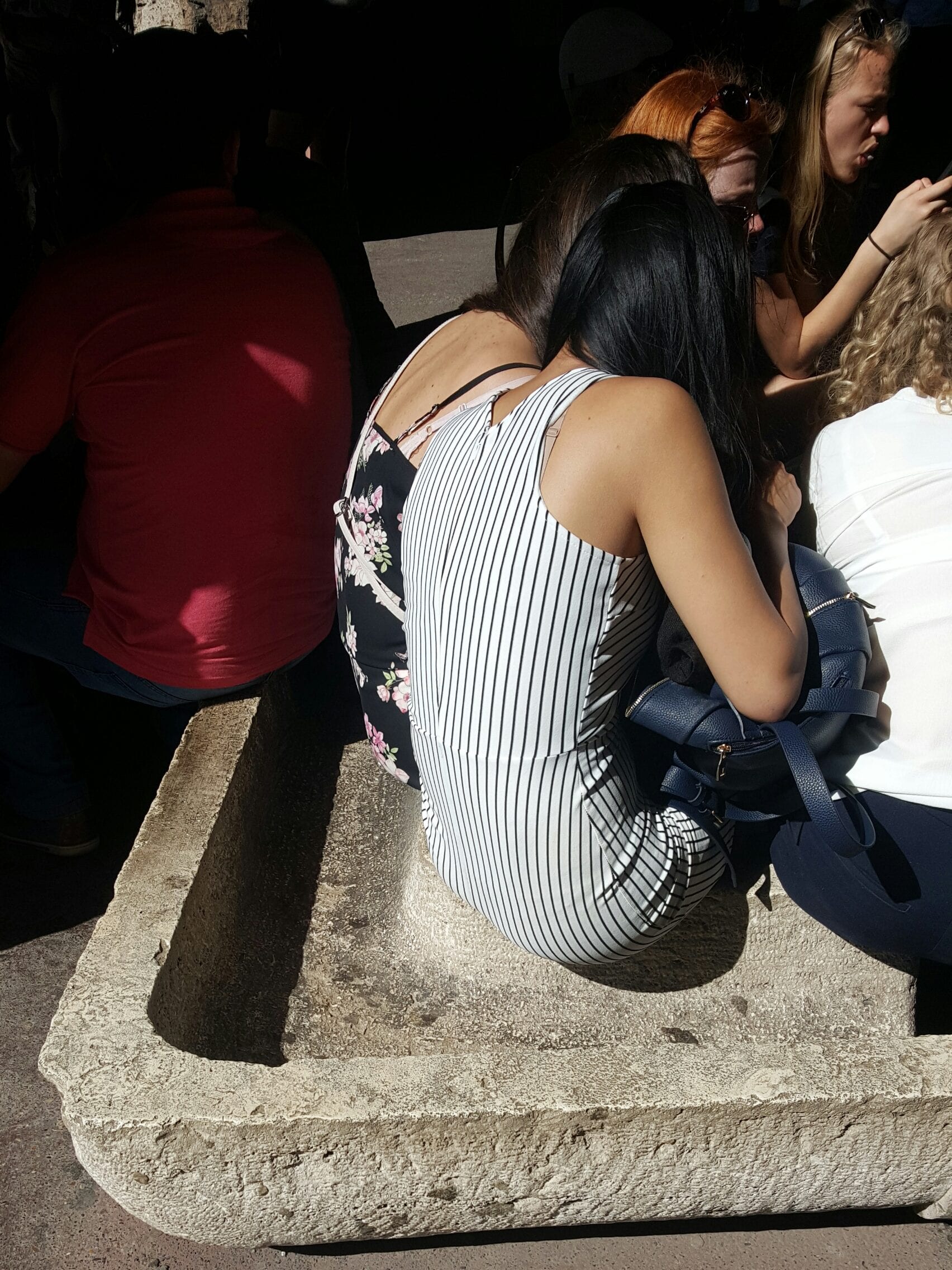
The American girls resting on this trough giggled uncomfortably when we asked them if they realized they were sitting on an ancient urinal
In contrast to the sophisticated sanitary facilities we saw in Ephesus, the Colosseum’s public latrines were nothing but troughs. It is believed that the urine collected in them was sold to fabric manufacturers, who used the ammonia-rich liquid to set dyes.
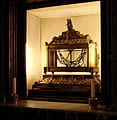
St. Peter’s Chains
Our last stop of the afternoon was a brief one at the church of San Pietro in Vincoli (St. Peter in Chains: it shares a name with Cincinnati’s cathedral). A reliquary under the altar holds a chain said to be one that shackled Peter while he was imprisoned in Jerusalem, broken by the angel who aided his escape, plus a chain that bound him in Rome’s Mamertine Prison. According to legend, the two miraculously fused when they were brought together by Pope Leo I.
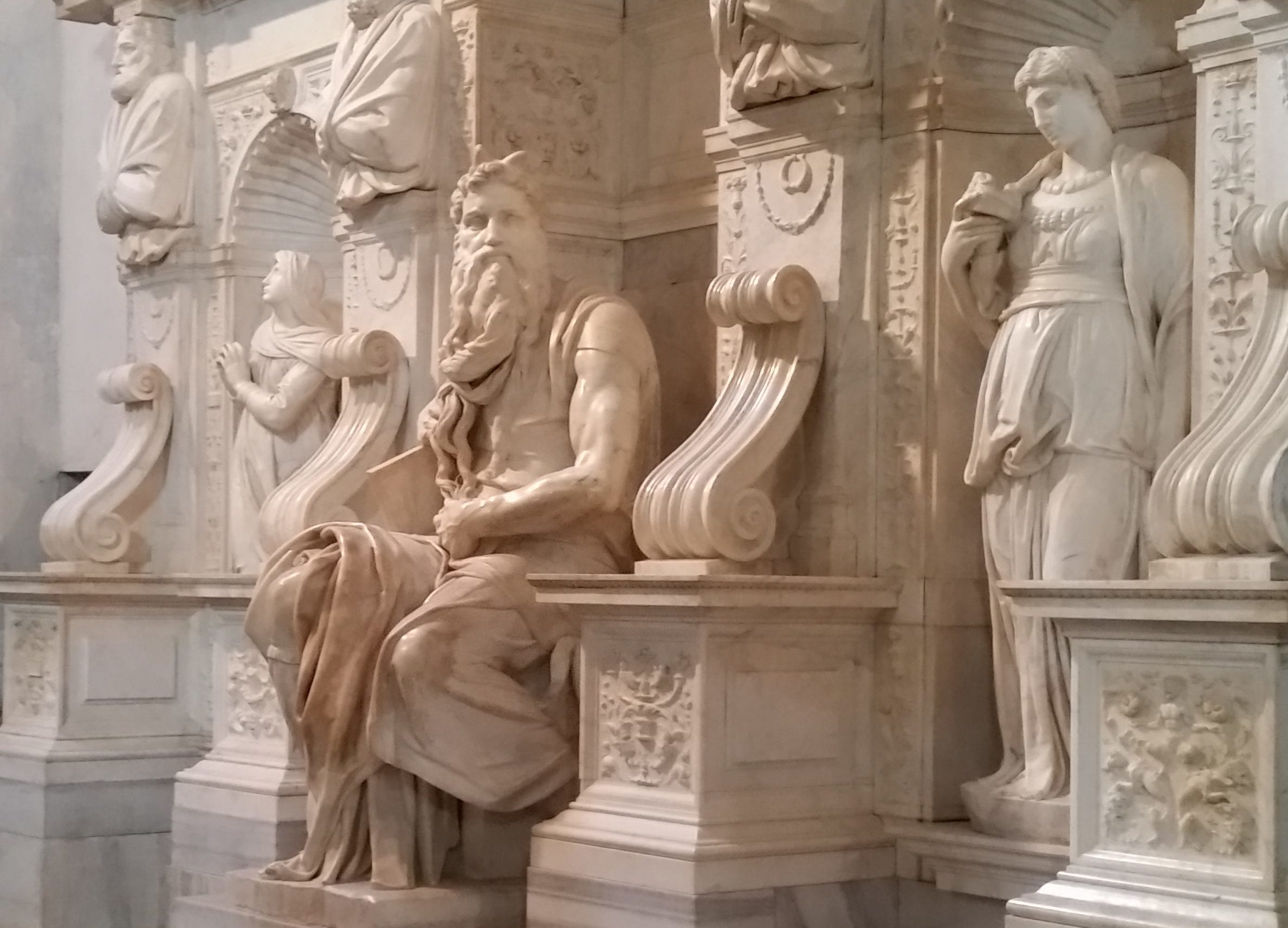
Michelangelo’s Moses
However, we were more interested in seeing Michelangelo’s sculpture of Moses, whose provenance is more certain than that of the chains. It decorates the tomb of Pope Julius II, which stands to the right of the altar. The horns sprouting from Moses’s head are the result of the Latin Vulgate’s unfortunate translation of a Hebrew word used to describe the prophet after he came down from Mt. Sinai; it can mean both “horned” and “emitting rays.”
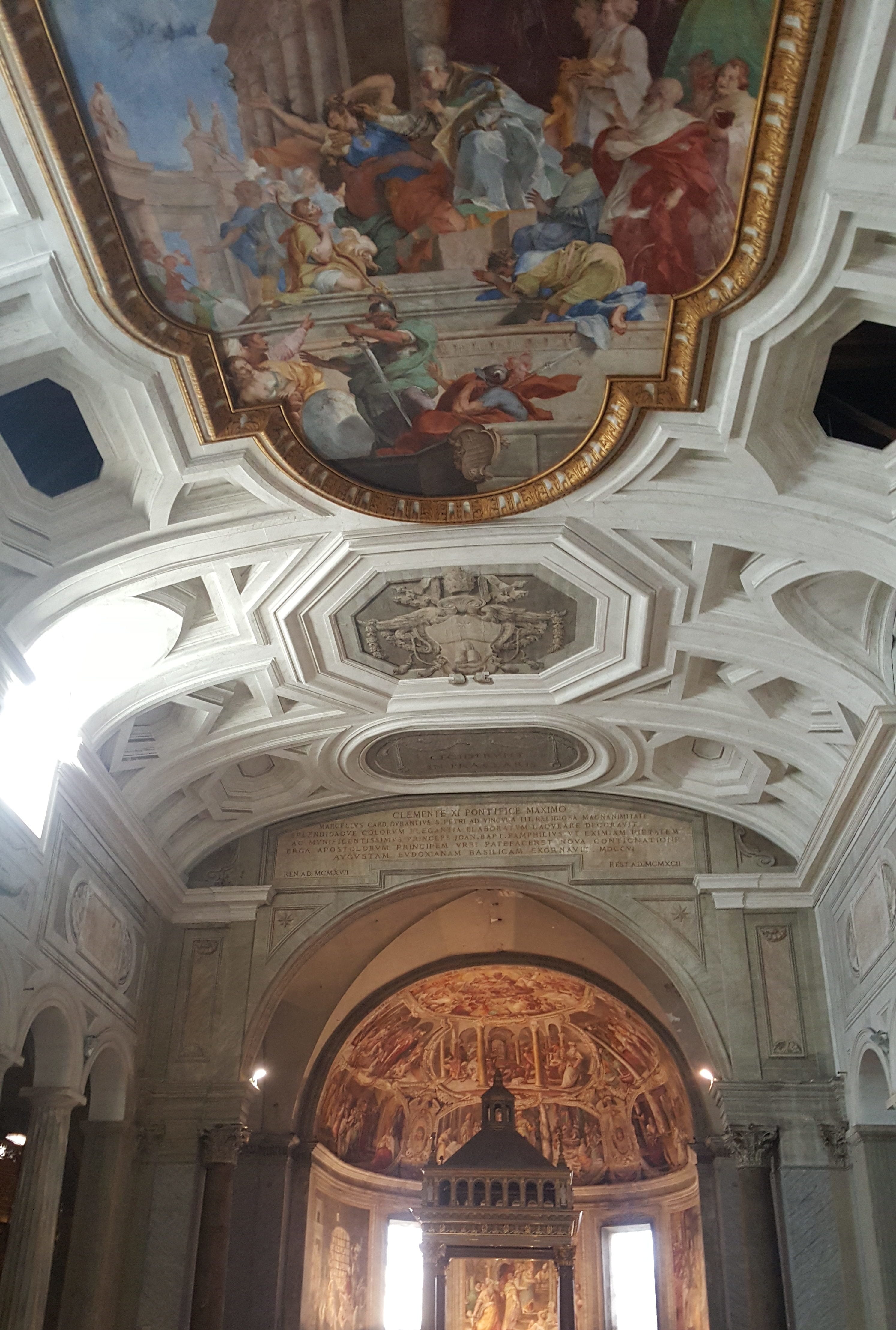
Interior of San Pietro in Vinculi
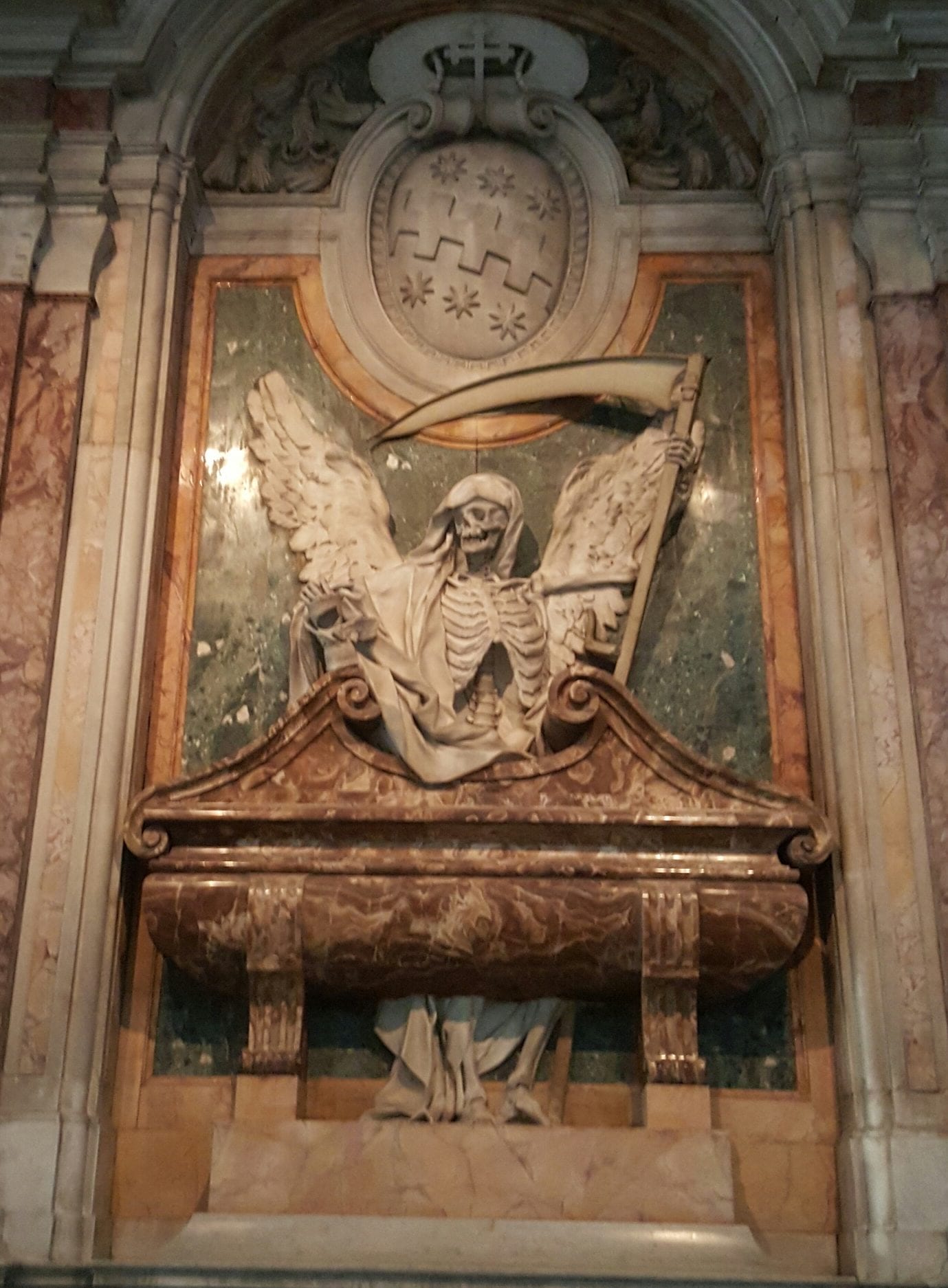
Tomb of Pope Clement VIII
The tomb of Pope Clement VIII, also in San Pietro in Vinculi, does not seem designed to comfort the living.
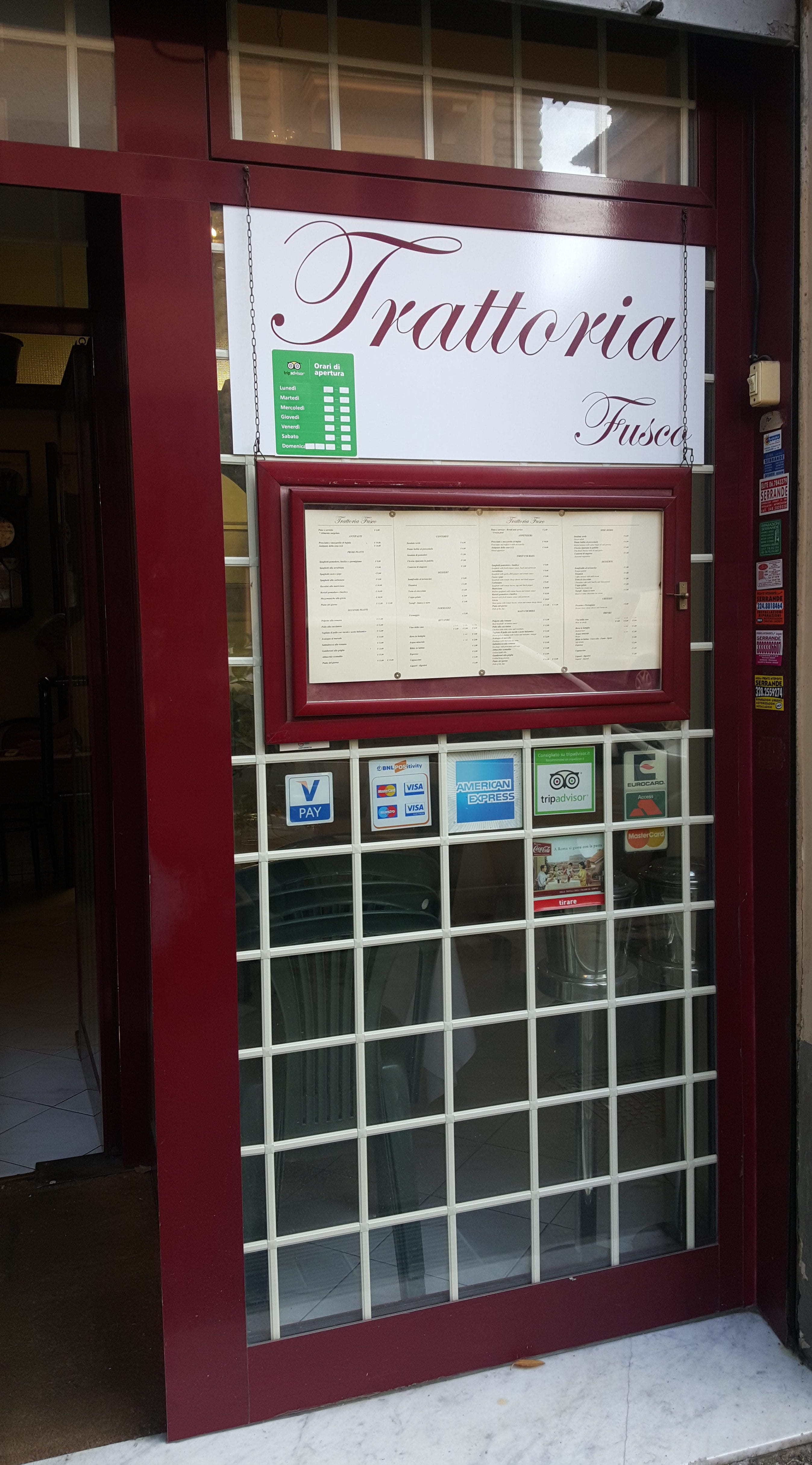
The entrance to Trattoria Fusco
When we returned to the hotel, we immediately logged onto the Internet and began searching for good restaurants. After last night’s dining debacle, we had decided to take the matter of choosing where to eat from then on into our own hands. TripAdvisor pointed us toward Trattoria Fusco, which had received good reviews and had the added advantage of being located only a few blocks from our hotel. So while part of the Gee Group headed back toward the area around the Colosseum to watch the sun set, Budge, Linda, Richard, Judith, Lynn, and Mark—all of whom know they can trust Michael and Nancy when it comes to food–followed us up the street and around the corner to Trattoria Fusco.
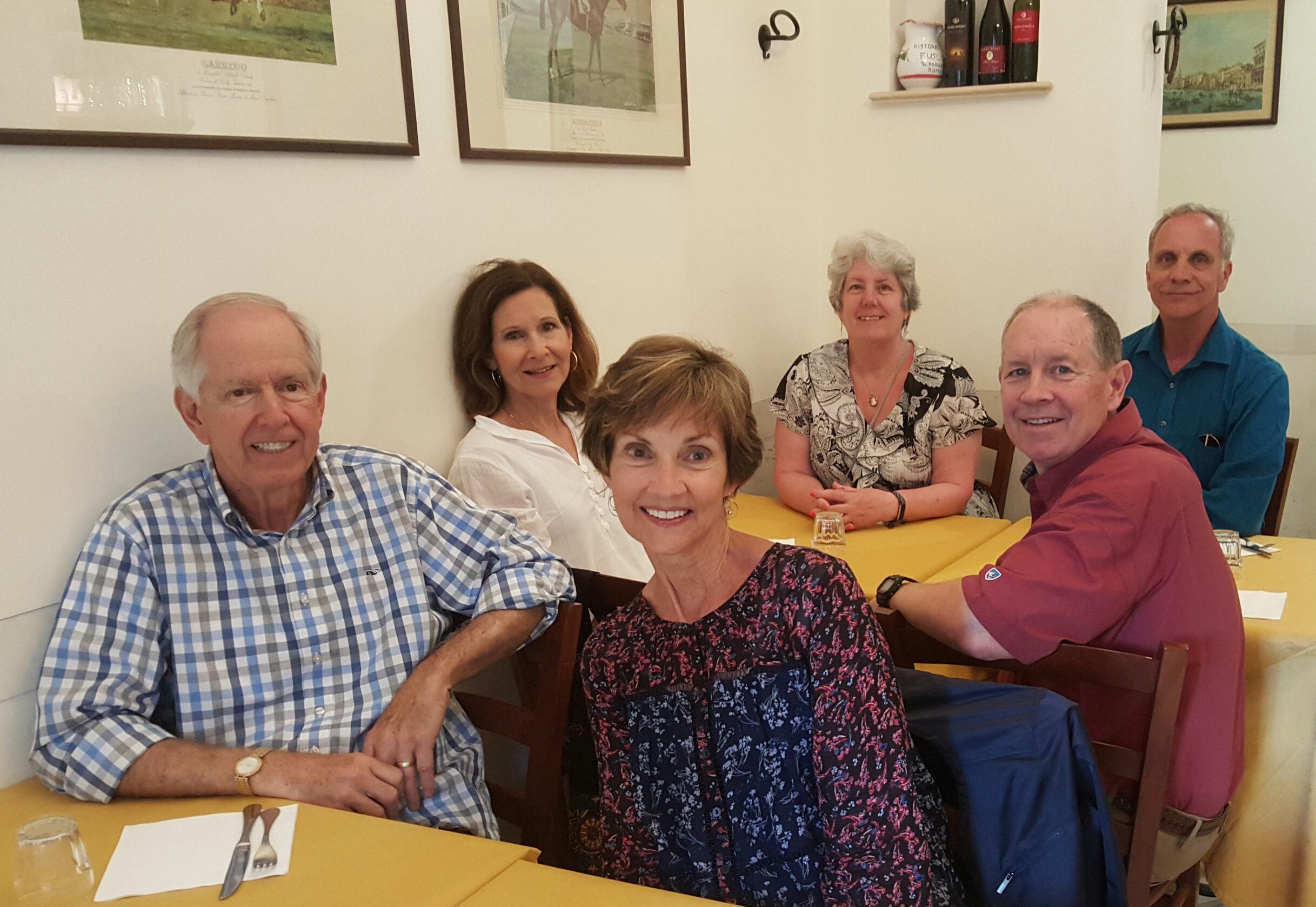
Budge and Linda, Judith and Richard, Lynn and Mark wait patiently for the trattoria to officially open
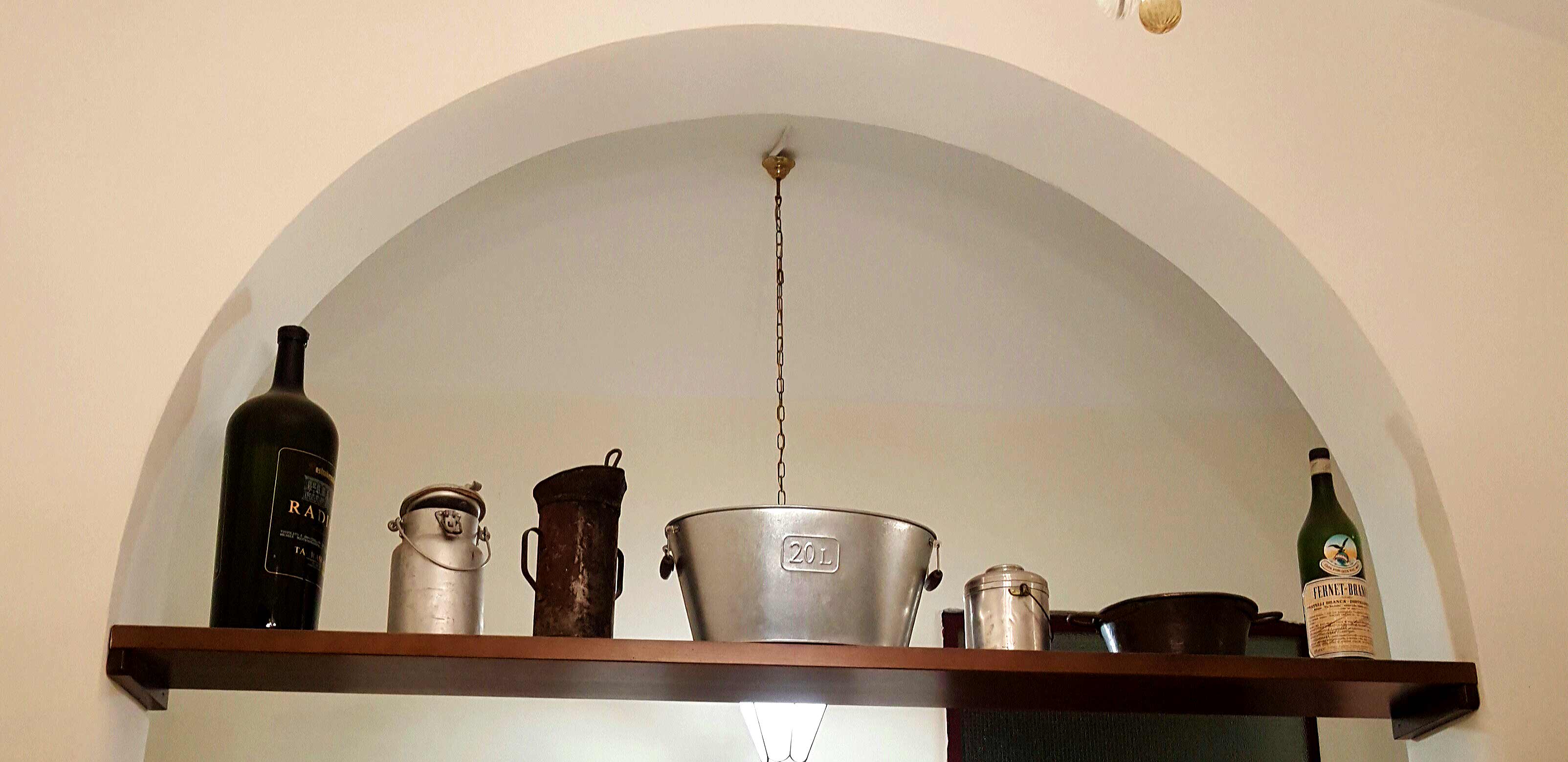
We suspect these items, decorating a shelf at Trattoria Fusco, were not purchased at a garage sale
Although we arrived about twenty minutes before opening time (7 p.m. seems to be the earliest anyone in Rome can imagine wanting to dine), the door was ajar, so we poked our heads inside to ask whether they would be able to accommodate a party of eight once they opened. The little gray-haired woman who had been bustling around inside spoke virtually no English and kept pointing at the hours sign on the window and repeating “no open, no open” in increasingly flustered tones, while we tried to assure her that we were content to wait until 7:00–as long as we could be certain that a table or two would be available once they were ready to open. Eventually she was able to communicate that her husband, who could speak English, would return shortly, and that it was all right for us to sit down inside until he could sort things out. So the eight of us went into the bright, unpretentious dining room and divided among two of its ten tables.
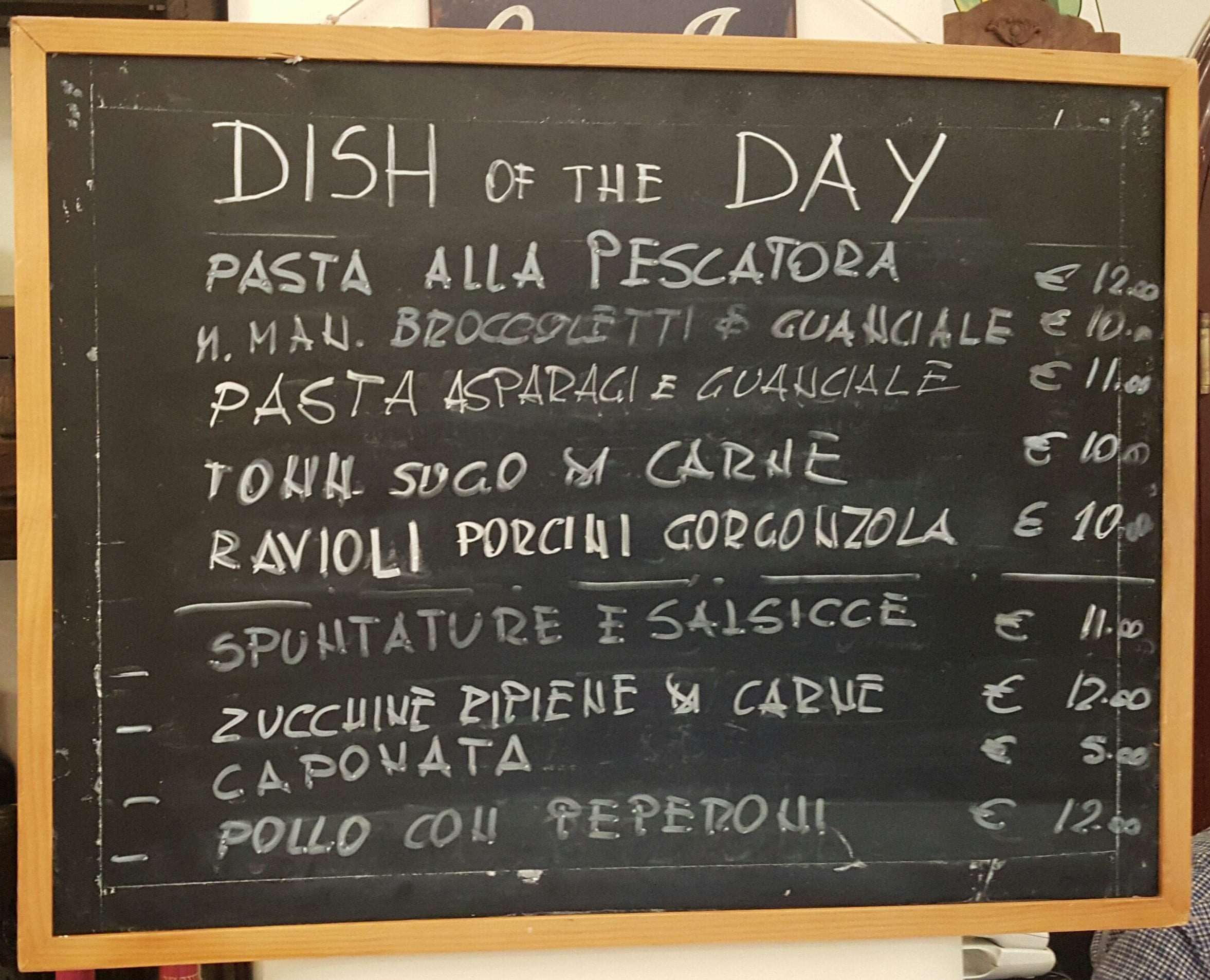
Today’s specials
By the time the husband returned (and consented to let us stay), we had perused the multilingual menu and tried to decipher the specials written on the chalkboard. His English was good enough to fill in the gaps and answer our questions. We were delighted to realize that this was a husband-and-wife operation, he the maitre d’ and she the chef. He brought us baskets of fresh bread, which we dipped in the best, fruitiest olive oil we’ve ever tasted. (Nancy is still berating herself for not taking careful note of the brand name.) Soon the waiter arrived, a young fellow who spoke excellent English. When we asked if he belonged to the family, he said no, but a while later he pointed out a young woman and a little girl who had taken a table on the other side of the room and told us that they were the daughter and granddaughter of the proprietors. Within the next hour, the remaining tables had filled up.
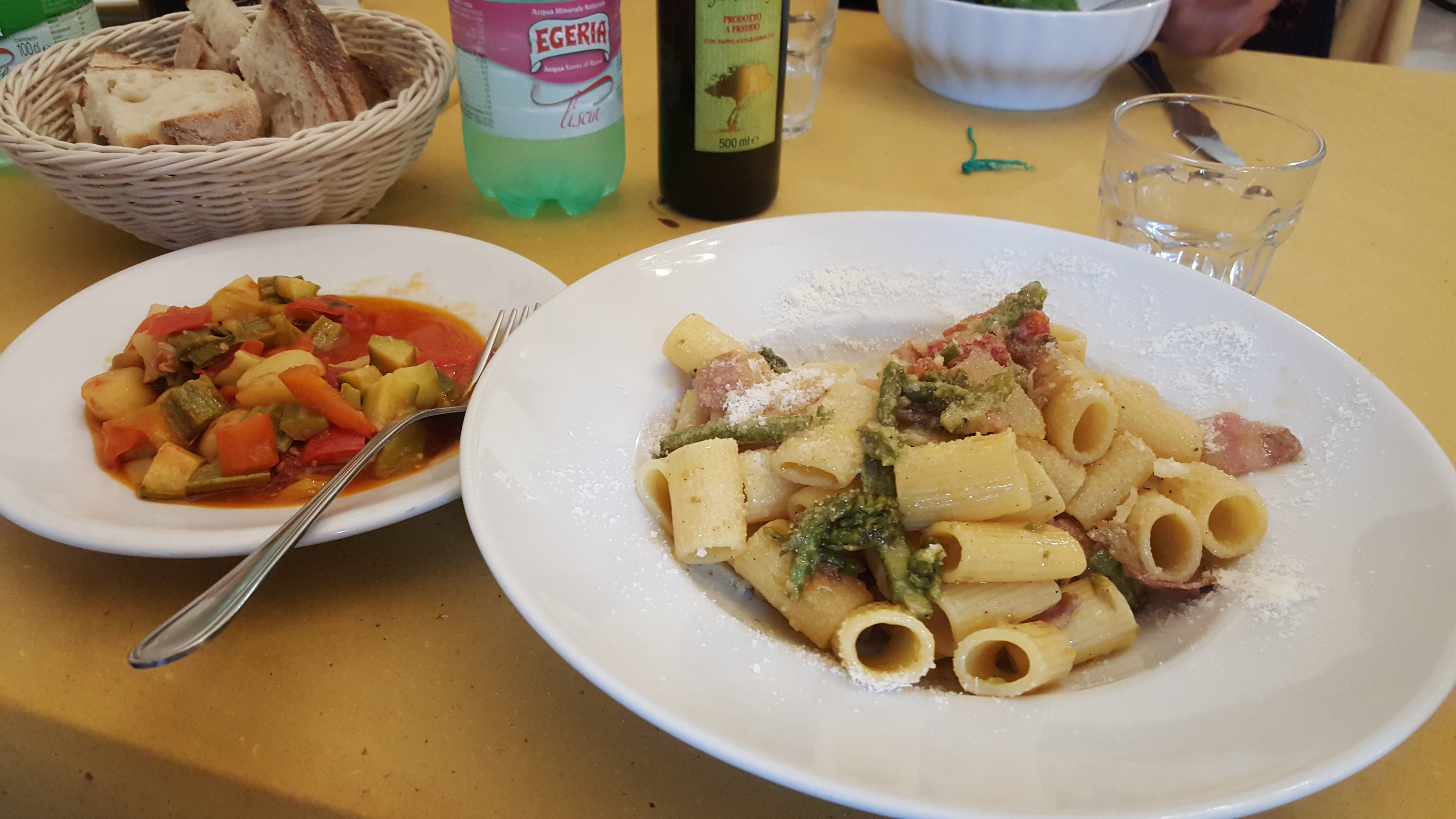
Nancy’s caponata and rigatoni with asparagus and guanciale
European waiters are always a bit nonplussed when we decline to order wine, but at least this one didn’t argue when we asked him to bring our salads before the entrée. Budge shared his antipasto plate, which included bites of buffalo mozzarella wrapped in slices of prosciutto that melted in your mouth. Michael had been undecided about whether to order veal from the regular menu or one of the specials, spare ribs and sausage, so he asked the maitre d’ which he would recommend. The man replied before Michael could even finish his query. “Ribs! Ribs! No question!” (We may never know how good the Veal Saltimbocca might have been, but the ribs and sausage were definitely delicious: tender as in good southern barbecue, but seasoned as an Italian would do them.) Nancy tried two other specials: rigatoni with asparagus and cured pork cheek (which sounds a lot more appetizing when said in Italian: guanciale), and the vegetable of the day, which was a savory caponata (diced sautéed vegetables in a light tomato sauce, with just the right amount of garlic). The conversation at our table was as captivating as the cuisine: Budge and Linda gave us a capsule history of their nearly fifty years in Cincinnati, featuring stories from the early days of the Cincinnati LDS Stake, and amusing descriptions of some colorful characters they had met along their way.
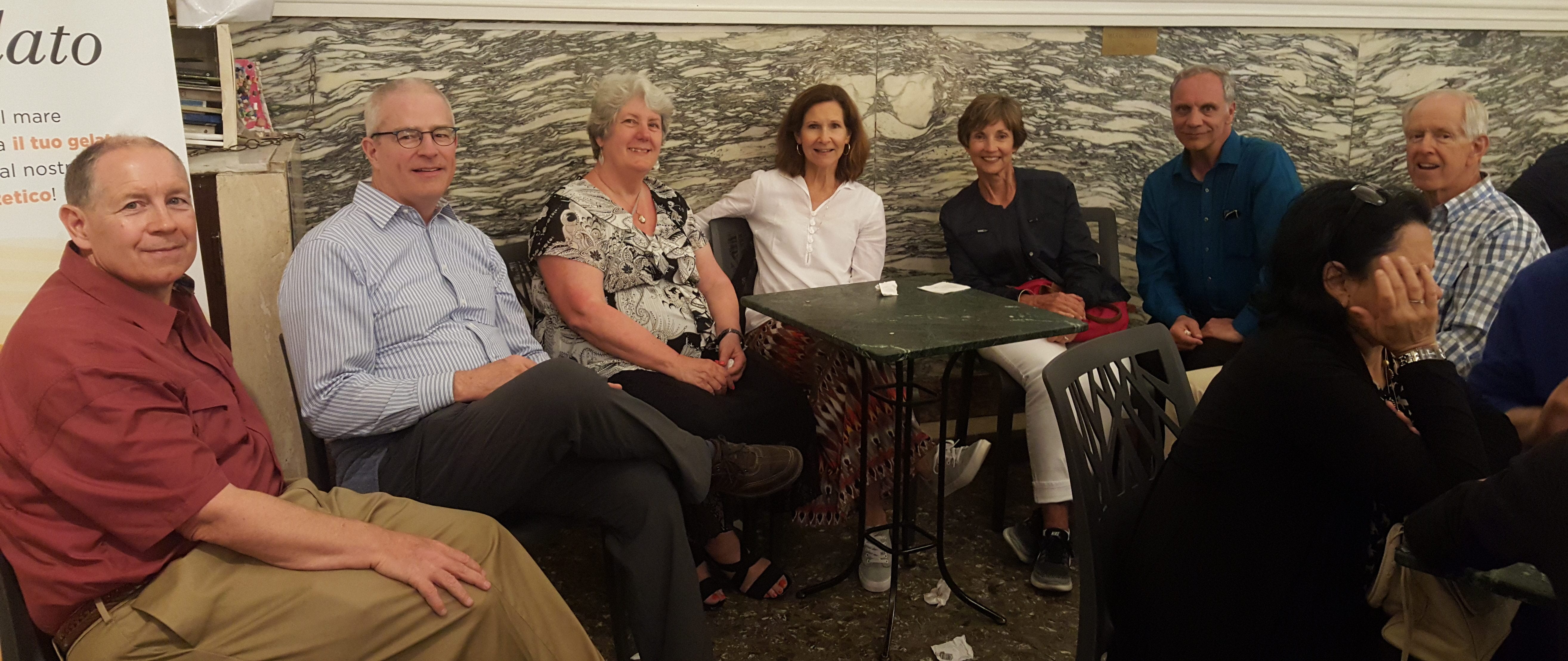
Tonight’s group at G. Fassi: Richard, Michael, Lynn, Judith, Linda, Mark, and Budge
No doubt the desserts offered at Trattoria Fusco would have been as satisfying as our dinner, but those of our group who had not been to G. Fassi last night were eager to try the fabulous gelato we had told them about, and Judith and Richard were just as eager as we to go back. Once we had paid the tab and thanked our hosts at the trattoria, Michael led the way to the gelateria. Nancy already knew what she wanted: dark chocolate and mandarin orange. Michael went for mango, melon, and mixed berry. The eight of us may have missed seeing the beautiful sunset behind the Colosseum tonight–but we and our companions had the best gelato in all of Rome.
Leave A Comment